My research works relate to the study of aesthetic-epistemological-praxeological constraints and determinations of Design Practice in its collaboration/cooperation with Engineering Sciences (in particular).
Please note that the definitive versions of these papers are the published versions. The PostScript versions are sometimes provided here as a courtesy, and, in some cases, there may be differences between the PostScript provided here and the published version. I believe that all of the differences are either formatting differences or copy-editing changes. If you cite these papers, please cite the published version rather than giving a URL.
[Book] Du gouvernement des formes
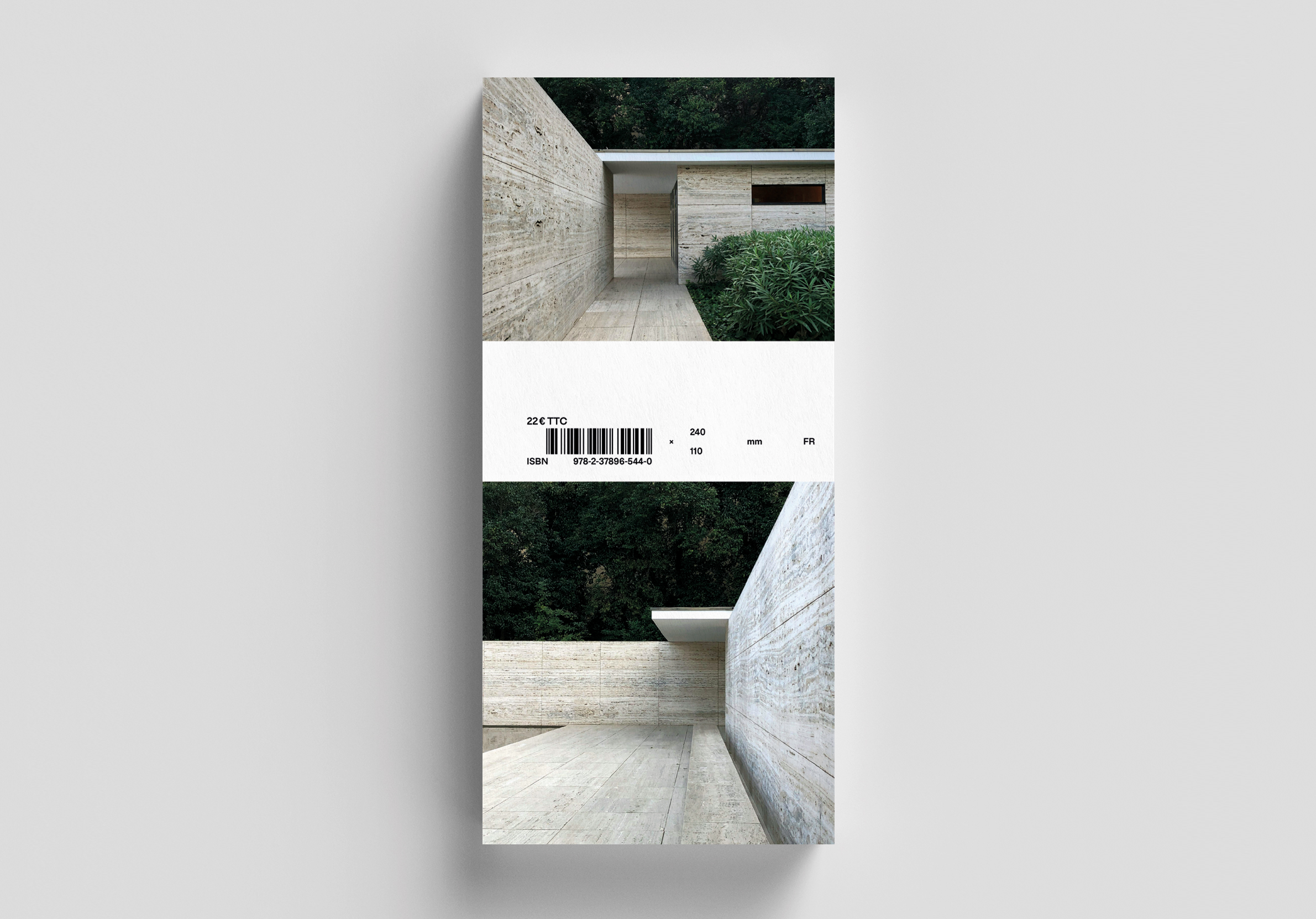
David Bihanic (2025) Du gouvernement des formes. Essai sur l’architecture et le design. Dijon : Les Presses du réel, 296 p.
L’architecture et le design partagent un même souci des formes, tous deux les considérant moins pour ce qu’elles sont que pour ce qu’elles peuvent, pour ce qu’elles engagent et ouvrent comme possibilités. N’aspirant pas à avoir empire sur elles, ils assumeraient, l’un et l’autre à leur manière, de gouverner les formes, au sens d’un ménagement (das Schonen), pour que dérivent d’elles tant l’apparence que l’utilité de bâtiments, d’objets nouveaux entre autres choses. Au sein de cet essai, David Bihanic s’attelle à clarifier la contribution commune de l’architecture et du design au dessein des formes, précisant en quoi celle-ci s’avèrerait tout entière retenue à un >accomplissement.
Architecture and design share the same concern for forms, both considering them less for what they are than for what they can, for what they engage and open up as possibilities. Not aspiring to “dominance” over them, they would both assume in their own way, to govern forms, in the sense of a “careful” treatment (das Schonen, in reference to the Heideggerian terminology), so that the appearance as well as the usefulness of new buildings and objects, among other things, derive from them. In this essay, David Bihanic endeavors to clarify the common contribution of architecture and design to the “purpose” of forms, specifying how this would in turn lead to an accomplishment.
To order the book, click here. Only available in French.
©Les presses du réel, Dijon 2025
D. Bihanic Du gouvernement des formes. Essai sur l’architecture et le design
110 × 240 mm
ISBN 978-2-37896-544-0
EAN 782378965440
[Book] Arrangements #1. Aménager l’espace, orner les lieux.
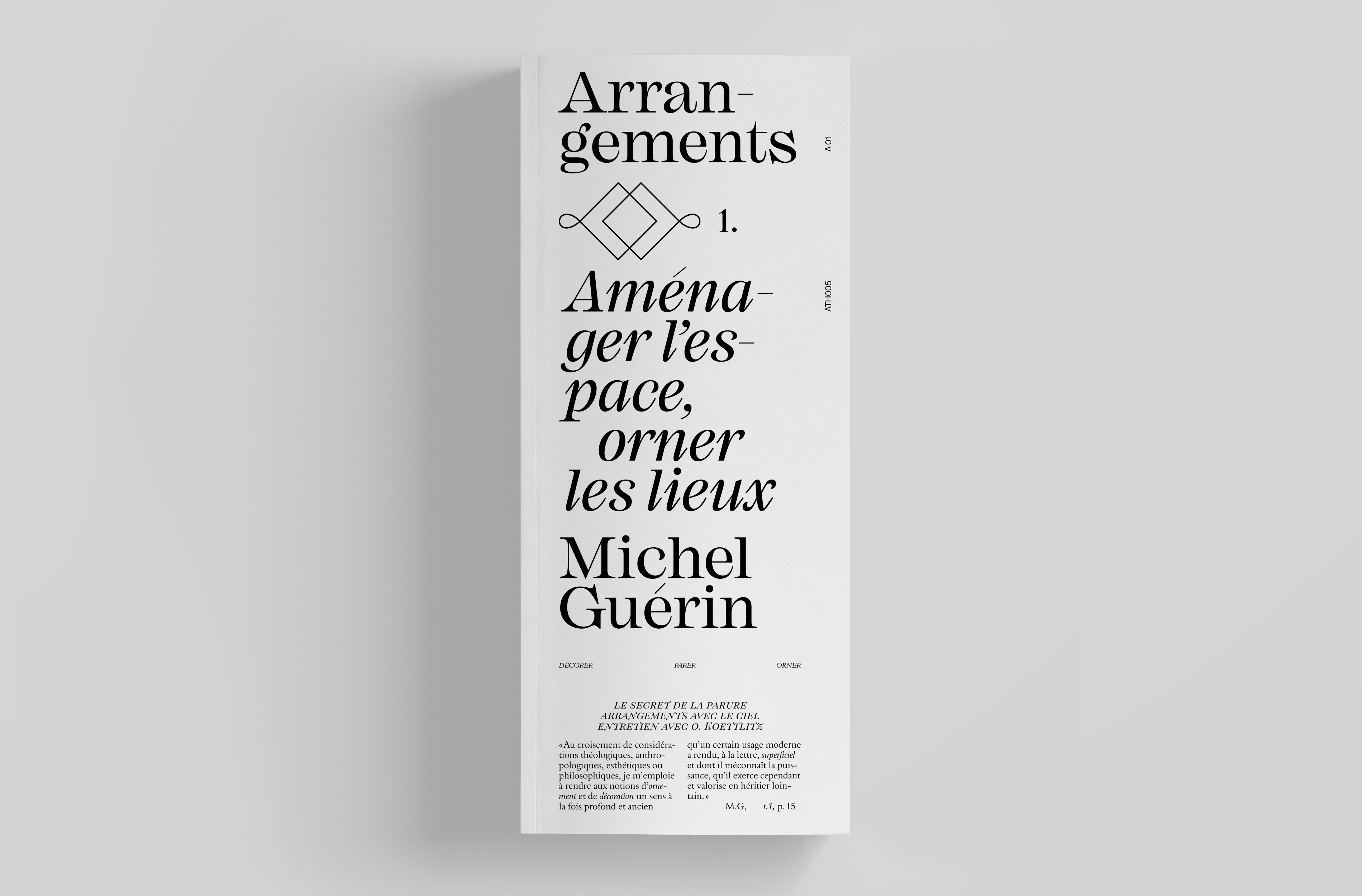
David Bihanic, Bernard Gabillon, Olivier Koettlitz, Aurélien Maillard (editorial direction of Michel Guérin’s book) (2024) Arrangements #1. Aménager l’espace, orner les lieux. Lille : Athom Éditions, First Issue (Arrangements), 96 p.
« Au croisement de considérations théologiques, anthropologiques, esthétiques ou philosophiques, je m’emploie là à rendre aux notions d’ornement et de décoration un sens à la fois profond et ancien qu’un certain usage moderne a rendu, à la lettre, superficiel et dont il méconnaît la puissance, qu’il exerce cependant et valorise en héritier lointain. » — Quote from Michel Guérin.
To order the book, click here. Only available in French.
©Athom Édition-Publishing, Lille 2024
David Bihanic, Bernard Gabillon, Olivier Koettlitz, Aurélien Maillard (editorial direction of Michel Guérin’s book), Arrangements #1. Aménager l’espace, orner les lieux
110 × 260 mm
ISBN 978-2-9573855-5-3
EAN 9782957385553
[Book] Anne-Valérie Gasc. Machines aveugles
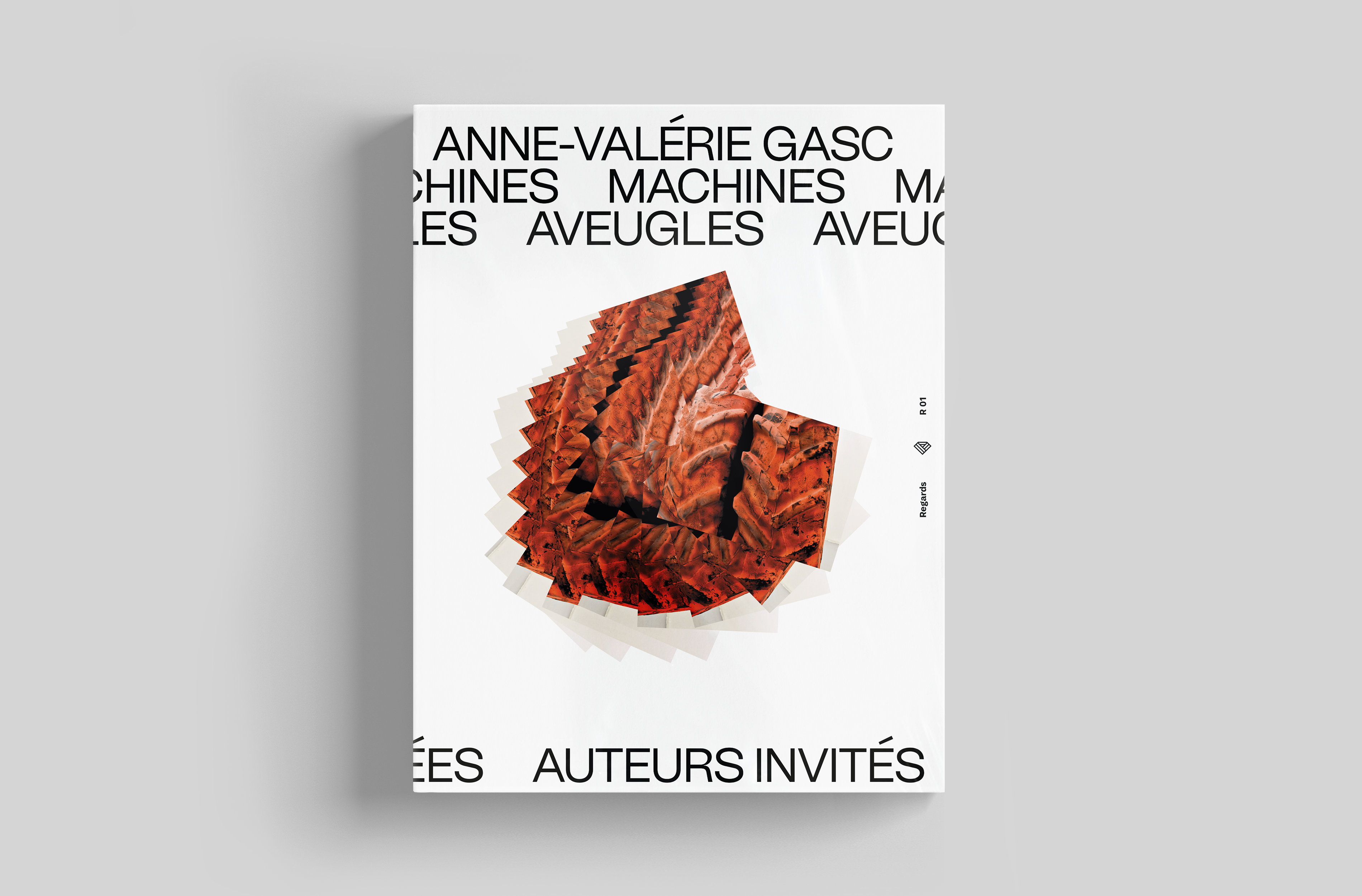
David Bihanic, Bernard Gabillon, Olivier Koettlitz, Aurélien Maillard (dir.) (2022) Anne-Valérie Gasc. Machines aveugles. Lille : Athom Éditions, 226 p.
Co-édition L’Espace de l’Art Concret (eac.) et Athom Éditions, avec le soutien de Mécènes du sud et Le Centre national des arts plastiques (Cnap).
Premier numéro de la collection Regards aux éditions Athom, cet ouvrage collectif compose un essai critique (abondamment illustré) traitant des principaux sujets et questionnements que soulève l’œuvre de l’artiste Anne-Valérie Gasc exposée à l’Espace de l’Art Concret — Exposition intitulée « Machines aveugles » ouverte au public du 10 juillet au 16 octobre 2022.
Ni la violence, ni le spectaculaire ne définissent l’œuvre d’Anne-Valérie Gasc. Pourtant, c’est bien la notion même de destruction qui en constitue l’enjeu. L’artiste envisage ce processus comme un moyen destiné à provoquer une modification de notre perception du réel. Elle élabore des stratégies précises de démolition (onde de choc, sabotage hydraulique, affaiblissement de structures, embrasement) qui mettent en crise la certitude investies dans nos espaces construits. Ainsi, ses œuvres sont autant de dispositifs qui impriment ou filment à l’aveugle, logeant l’avènement de l’art dans ce qui échappe au prévisible et au contrôle. Ce principe de création traduit chez l’artiste une volonté d’interroger notre époque dont les ambitions sociales et politiques, d’apparence généreuses et modernistes, semblent inévitablement s’effondrer.
To order the book, click here. Only available in French (abstracts in English).
List of authors:
• Jean-Christophe Arcos, Independent Curator, Paris, France,
• David Bihanic, University of Paris 1 Pantheon-Sorbonne; “École nationale supérieure des Arts Décoratifs”, Paris, France,
• Léa Bismuth, Independent Curator, Art Critic, Paris, France,
• Sally Bonn, University “Picardie Jules Verne”, Amiens, France,
• Emmanuelle Chiappone-Piriou, Independent Architect, Paris, France,
• Nartahlie Delbard, University of Lille, Lille, France,
• Ludovic Duhem, “École Supérieure d’Art et de Design de Valenciennes”, Valenciennes, France,
• Florian Gaité, “École Supérieure d’Art d’Aix-en-Provence”, Aix-en-Provence, France,
• Léo Guy-Denarcy, “Onde” Art Center, Vélizy-Villacoublay, France,
• Seloua Luste Boulbina, “Collège de France”; University Paris Cité, Paris, France,
• Marianne Massin, Unversity Sorbonne, Paris, France,
• Judith Michalet, University of Paris 1 Pantheon-Sorbonne, Paris, France,
• Jaune Parque, “École d’Architecture et de Paysage de Lille”, Lille, France,
• Emanuele Quinz, University Paris 8, Paris, France,
• Océane Ragoucy, “École Nationale Supérieure d’Architecture de Paris-Malaquais”; AOC journal, Paris, France.
©Athom Édition-Publishing/L’Espace de l’Art Concret, Lille/Mouans-Sartoux 2022
D. Bihanic, B. Gabillon, O. Koettlitz, A. Maillard (sous la dir.), Anne-Valérie Gasc. Machines aveugles
230 × 300 mm
ISBN 978-2-9573855-2-2
EAN 9782957385522
[Book] Matrices
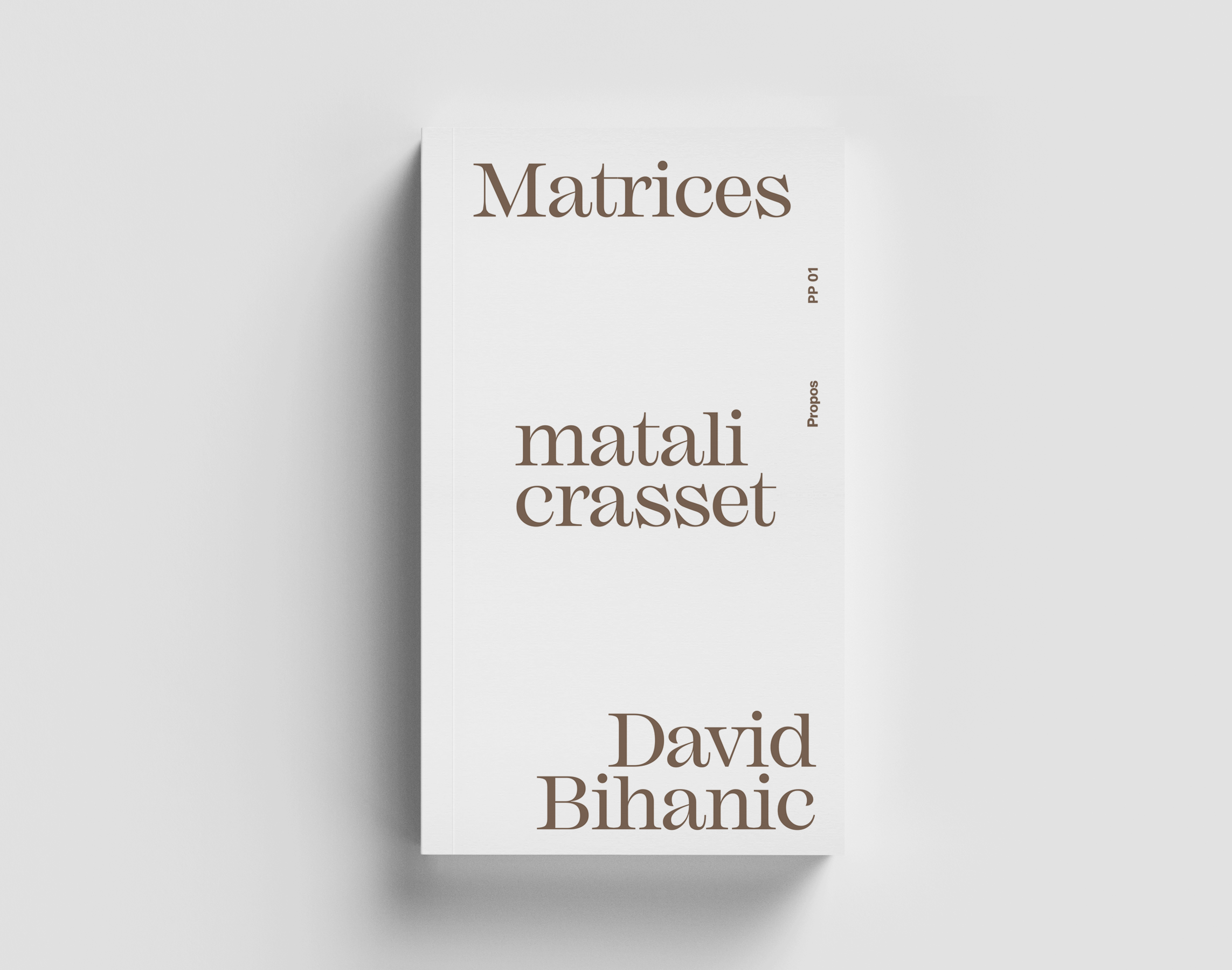
matali crasset, David Bihanic (2022) Matrices. Dijon : Les Presses du réel/Lille : Athom Éditions, 140 p.
Face au péril écologique, que peuvent le design, l’architecture, sinon favoriser, accompagner des modes et manières de vivre entretenant un rapport renouvelé à la nature ? Partant de réalisations et projets, Matali Crasset et David Bihanic se partagent l’écriture de cet ouvrage cherchant ensemble, entre témoignage et analyse, à caractériser un design de matrices.
Faced with environmental threats, what design and architecture can do other than encourage ways of living that maintain a renewed relationship with nature? Based on new house projects, matali crasset and David Bihanic wrote this book with four hands, seeking together — between testimony and analysis — to characterize a design of matrices.
First issue of the collection “Propos” at Athom Publishing, this book is written with four hands by matali crasset and David Bihanic. It includes a picture section (in full color) of matali crasset’s house design projects.
To order the book, click here. Only available in French.
©Les presses du réel/Athom Édition-Publishing, Dijon/Lille 2022
M. Crasset, D. Bihanic Matrices
105 × 180 mm
ISBN (Les presses du réel) 978-2-37896-356-9
EAN (Les presses du réel) 9782378963569
ISBN (Athom) 978-2-9573855-4-6
EAN (Athom) 9782957385546
[Book] Marcel Lods. Éduquer à l’architecture moderne
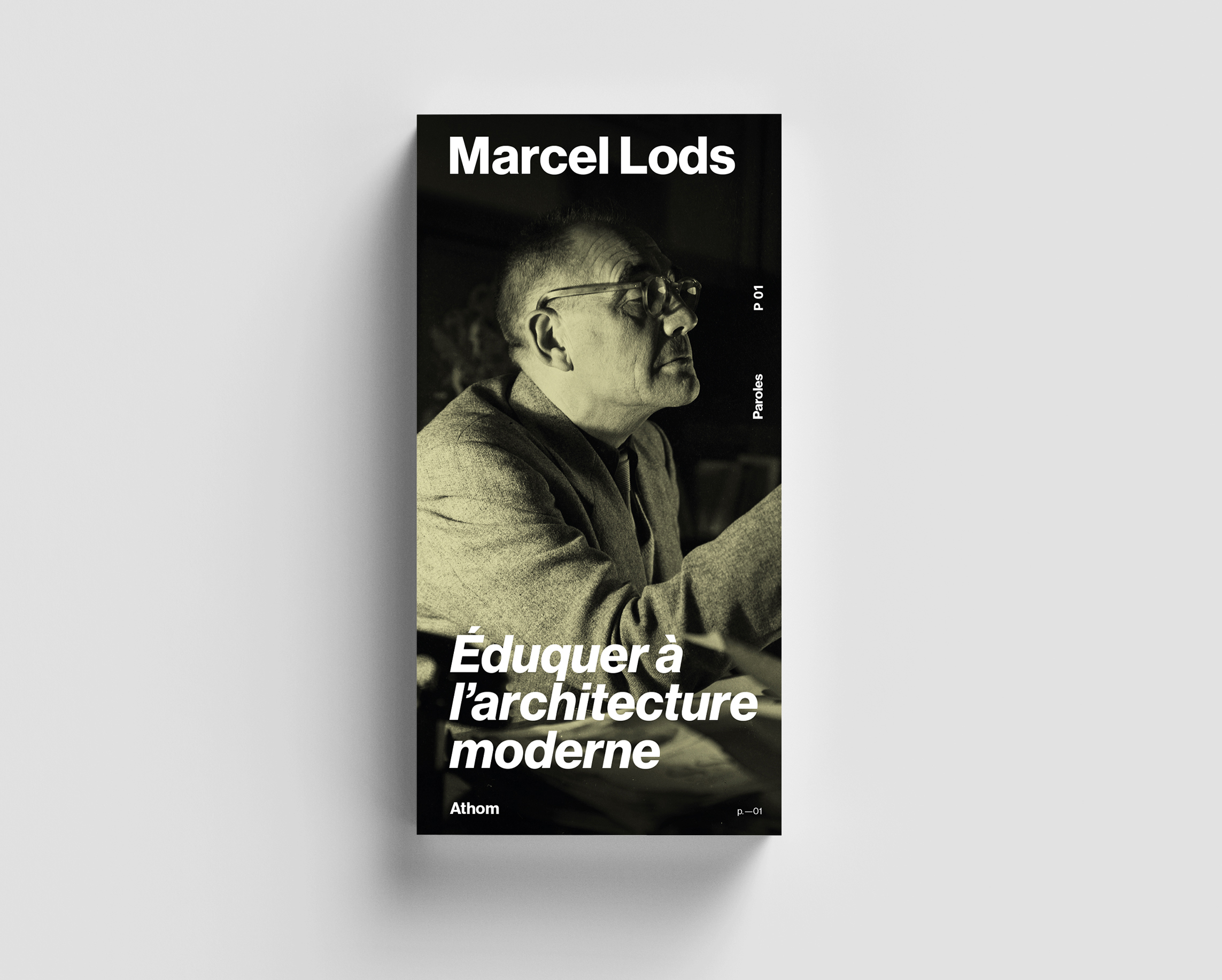
David Bihanic, Pieter Uyttenhove (dir.) (2022) Marcel Lods. Éduquer à l’architecture moderne. Lille : Athom Éditions, 356 p.
Recueil de textes inédits et d’une qualité rare (écrits et transcriptions de conférences) de l’architecte-urbaniste français Marcel Lods (1891-1978) auxquels se joignent des analyses, études et commentaires d’auteurs invités.
Si l’œuvre de Marcel Lods est, pour une assez large part, connue de tous en France comme à l’étranger – cela à la faveur de nombreuses constructions « manifestes » du mouvement moderne –, force est de constater qu’une part substantielle de sa réflexion sur l’architecture et planification territoriale demeure à ce jour sinon ignorée, à tout le moins confidentielle. Pourtant, Marcel Lods aura eu à cœur, tout au long de sa carrière, d’en énoncer publiquement les termes, notions, concepts et idées-clés au sein de différentes publications, d’exprimer et de partager ses vues, ses conceptions et positions souvent radicales à l’occasion de conférences, également d’entretiens avec la presse et les médias. Dès lors, de toutes ces paroles, il ne reste à présent que des traces écrites relativement éparses – bien que consciencieusement archivées –, des retranscriptions, des notes et brouillons que l’architecte aura pris soin de conserver, également des commentaires, des rédactions et compositions dont plusieurs resteront inachevés. Cet ouvrage est le premier d’une nouvelle collection aux éditions Athom intitulée « Paroles » laquelle, partant de retranscriptions de conférences et écrits de créateurs éminents (architectes, designers, artistes) – un « matériau » inédit sinon extrait de publications aujourd’hui épuisées – propose d’en reconsidérer le sens, d’en réévaluer la portée (ou visée) ainsi que l’influence fort d’études, d’analyses et points de vue historiographiques critiques réalisés par des auteurs de profils et appartenances disciplinaires variés (histoire, philosophie, esthétique et sciences de l’art, anthropologie, etc.). Au sein de ce volume, ont été retenus sept textes produits par Marcel Lods entre 1947 et 1967 : des notes de lecture et d’écriture en préparation d’articles, un rapport d’étude/d’expertise, des essais dans leur version de travail ainsi que des retranscriptions écrites de conférences. Sept textes pour lesquels le propos aura été évidemment adapté à la cible (lectorat ou audience) mais dont la réunion, au sein de ce livre, fait très clairement apparaître les nombreux « échos », les relations de sens et complémentarités. L’ouvrage est complété d’une biographie de Marcel Lods par Pieter Uyttenhove, et d’interprétations des textes du constructeur par six auteurs invités, de profils et expertises distincts, qui reviennent, chacun à leur façon, sur certains passages, relèvent et démêlent quelques-uns des « points » ou « nœuds » problématiques et s’attachent, en définitive, à remettre « les choses » en perspective ; ceci concourant à démontrer – puisqu’il le fallait – combien le recours à la pensée de Marcel Lods demeure toujours aussi précieux, fécond et utile en vue de traiter des enjeux et questions essentiels de l’architecture, d’hier à aujourd’hui.
Mini-biography of Marcel Lods (in french)
Architecte et urbanisme français, pionnier de la préfabrication et ardent défenseur de l’industrialisation intégrale du bâtiment, Marcel Lods (1891-1978) est une figure incontournable de l’architecture moderne. Associé d’Eugène Beaudouin jusqu’en 1940, ils bâtirent ensemble des ouvrages « clés » dont la cité du champ des oiseaux (1930-1939), la cité de Muette (1931-1934), l’école de plein air de Suresnes (1934-1935) ou encore la Maison du Peuple de Clichy (1935-1939). Outre sa fonction d’architecte-urbaniste, Lods était également aviateur, photographe, grand conférencier et enseignant. Il était homme de passion et de conviction ayant à maintes reprises écrit, témoigné dans les médias (presse généraliste et presse spécialisée, radio). Il participa, en qualité d’expert, à plusieurs projets de réforme touchant notamment à l’enseignement de la profession d’architecte. Acteur de premier plan de la planification urbaine en France (pour une ville idéale), il est souvent présenté comme le « père des Grands Ensembles ». On lui doit notamment, après-guerre, celui de la Zone Verte à Sotteville-Lès-Rouen (1966), également la cité Paul Eluard à Drancy et celle de la Grand-Mare à Rouen (1968-1970).
First issue of the collection “Paroles” at Athom Publishing, this book gathers a selection of unpublished texts (writings and conference transcriptions) of the French Architect-Urban Planner Marcel Lods (1891-1978). The work is supplemented by a unpublished biography of the architect written by Pieter Uyttenhove, as well as studies, analyses conducted by guest authors (their names are mentioned below).
To order the book, click here. Only available in French.
List of authors:
• David Bihanic, University of Paris 1 Pantheon-Sorbonne; “École nationale supérieure des Arts Décoratifs”, Paris, France,
• Claire Brunet, “École Normale Supérieure”, Paris-Saclay, France,
• Éric Chauvier, “École Nationale Supérieure d’Architecture”, Versailles France,
• Richard Klein, “École Nationale Supérieure d’Architecture et de Paysage”, Lille, France,
• Antonella Tufano, University of Paris 1 Pantheon-Sorbonne, Paris, France,
• Pieter Uyttenhove, Ghent University, Belgium,
• Christophe Viart, University of Paris 1 Pantheon-Sorbonne, Paris, France.
©Athom Édition-Publishing, Lille 2022
D. Bihanic, P. Uyttenhove (sous la dir.), Marcel Lods. Éduquer à l’architecture moderne
110 × 220 mm
ISBN 978-2-9573855-1-5
EAN 9782957385515
[Book] Empavillonner
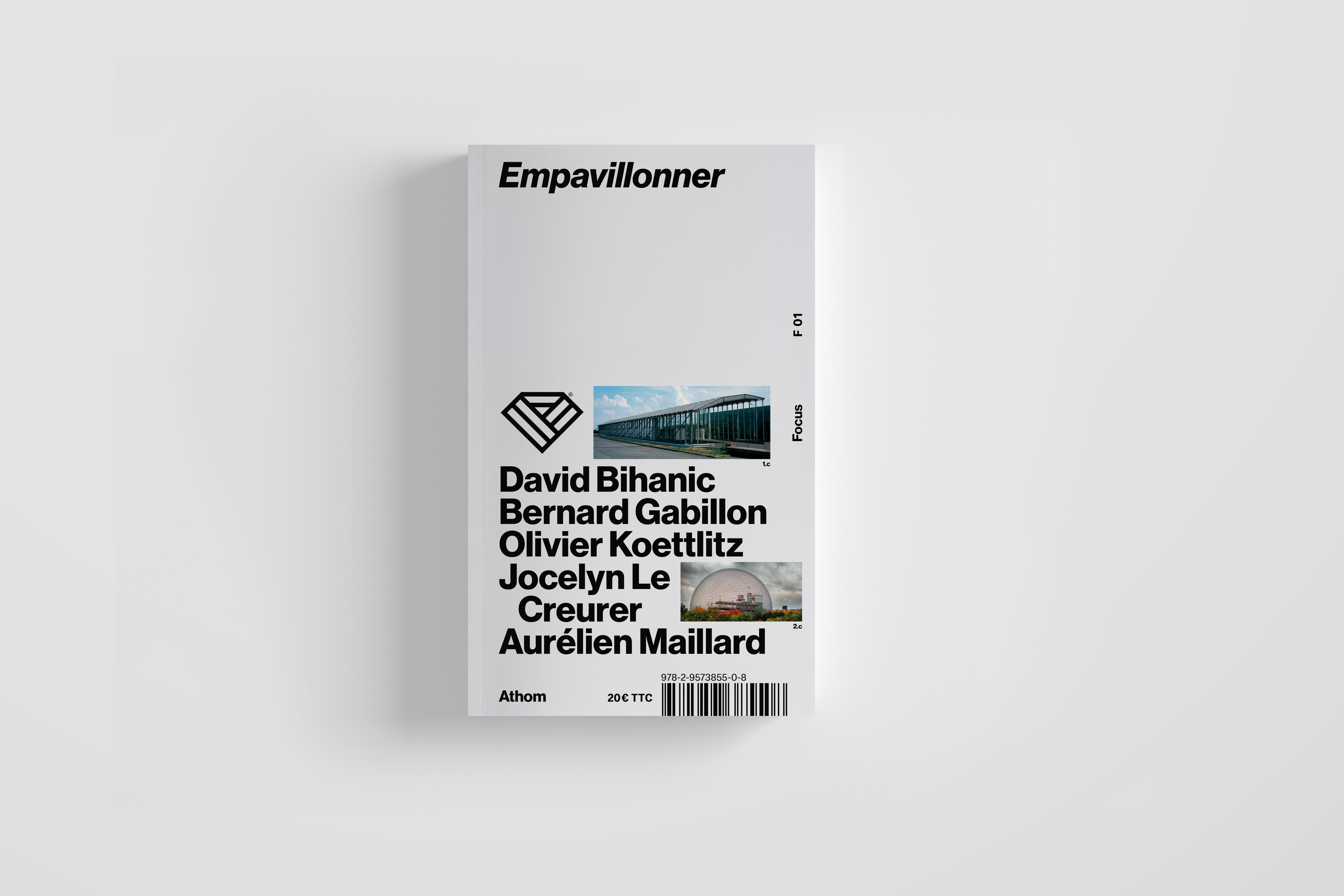
David Bihanic, Bernard Gabillon, Olivier Koettlitz, Jocelyn Le Creurer, Aurélien Maillard (dir.) (2021) Empavillonner. Lille : Athom Éditions, 412 p.
Qu’il s’agisse, entre autres exemples, du Pavillon France réalisé par l’architecte Jean-Paul Viguier à l’occasion de l’Exposition Universelle de Séville (1992), de celui des Pays-Bas signé de l’agence MVRDV dans le cadre l’Exposition Universelle d’Hanovre (2000) ou encore, avant eux, des pavillons présentés comme “manifestes de la modernité”, tels que ceux de Richard Buckminster Fuller (Pavillon États-Unis, île Sainte-Hélène, Montréal, 1967), de Le Corbusier (Pavillon Philips, Bruxelles, 1958) de Robert Mallet-Stevens et des frères Martel (Pavillon du tourisme, Paris, 1925), tous sembleraient procéder d’une même intention (ou prétention) : celle de définir les voies et préceptes d’une Architecture résolument nouvelle laquelle, contestant ou refusant parfois ce qui a cours, préfigure et marque de quoi serait faite l’époque à-venir. Profitant aujourd’hui d’un certain recul, il est permis de constater quel aura été le devenir de ces tentatives architecturales : pour bon nombre d’entre elles, des “reliques” d’un temps révolu, des ruines (à l’image d’éléphants blancs), également des friches ou encore des déserts… Les stigmates d’édifications avancées comme “prototypiques” alors tombées dans l’oubli. C’est comme si ce qui s’était naguère pensé, tenté n’avait été, en réalité, que la consécration et “apothéose” d’une Culture de l’éphémère : un brusque et bruyant “déballage” de savoir-faire souvent techniques-technologiques, l’empreinte autrefois rutilante d’une audace créative ou encore une authentique démonstration de force, de puissance (un geste à l’énergie concentrée et dispersée) consacrant l’emprise et assise économiques, culturelles des états commanditaires pris au cœur d’une inexorable compétition mondiale. Aussi, bien plus que de conclure à l’échec du nouveau — celui de ne pouvoir triompher qu’en de trop rares occasions —, reviendrait-il plutôt de s’interroger sur la fonction et les visées véritables de ces constructions, sur ce qui s’édifie et se programme vraiment au travers de la forme même du Pavillon, soit sur ce qui s’empavillonne. C’est-à-dire tout à la fois s’incorpore, se cristallise et se disperse en de multiples cellules pavillonnaires d’exposition entremêlant idées, visions, concepts et conceptions, également systèmes, stratégies, postures et positions tactiques… Conviendrait-il, en outre, de se demander quels places et rôles tiennent la maîtrise d’ouvrage ainsi que le commanditaire dans la pérennisation (et non seulement la conservation) de l’œuvre architecturale. C’est très exactement là le cadre d’étude de cet ouvrage : s’appuyant sur des exemples précis, il s’agit de comprendre et de donner à lire de quoi le Pavillon est effectivement le projet.
First issue of the collection “Focus” at Athom Publishing, this book brings together contributions from historians, philosophers, aestheticians, also architects, designers and artists for an in-depth analysis, from an architectural standpoint, of different Exhibition Pavilions (Universal and International Exhibitions; Bienniales), both past and present.
To order the book, click here. Only available in French.
List of authors:
• Jean-Christophe Arcos, Independent Curator, Paris, France,
• David Bihanic, University of Paris 1 Pantheon-Sorbonne; “École nationale supérieure des Arts Décoratifs”, Paris, France,
• Pierre Bourdareau, University of Bordeaux Montaigne, Bordeaux, France,
• Claire Brunet, “École Normale Supérieure” in Cachan, France,
• Jérémie Elalouf, University of Toulouse Jean Jaurès, Toulouse, France,
• Bernard Gabillon, “École Supérieure d’Arts Appliqués et Textile de Roubaix”, Roubaix, France,
• Catherine Geel, Nancy School of Art and Design; “École Normale Supérieure” in Cachan; Sciences-Po, Paris, France,
• Pierre-Damien Huygue, University of Paris 1 Pantheon-Sorbonne, Paris, France,
• Richard Klein, “École Nationale Supérieure d’Architecture et de Paysage”, Lille, France,
• Olivier Koettlitz, “École Supérieure d’Arts Appliqués et Textile de Roubaix”, Roubaix, France,
• Jocelyn Le Creurer, Independent Artist/Photographer, Paris, France,
• Salvator-John Liotta, “Université Libre de Bruxelles”; Laps Architecture, Paris,
• Pierre Litzler, University of Strasbourg, France,
• Philippe Louguet, “École Nationale Supérieure d’Architecture et de Paysage”, Lille, France,
• Fabienne Louyot, “École nationale supérieure d’architecture (Paris-Belleville)”; “Università Iuav di Venezia”; Laps Architecture, Paris, France,
• Aurélien Maillard, University of Lille; Bacqueville Art Gallery, Lille, France,
• Philippe Rahm, Architect, Paris, France,
• Philippe Rizzoti, Architect; “École Nationale Supérieure d’Architecture et de Paysage”, Paris, France,
• Didier Vivien, University of Lille, Lille, France.
©Athom Édition-Publishing, Lille 2021
D. Bihanic, B. Gabillon, O. Koettlitz, J. Le Creurer, A. Maillard (sous la dir.), Empavillonner
110 × 180 mm
ISBN 978-2-9573855-0-8
EAN 9782957385508
[Book] staatliche bauhaus cent pour cent 1919-2019
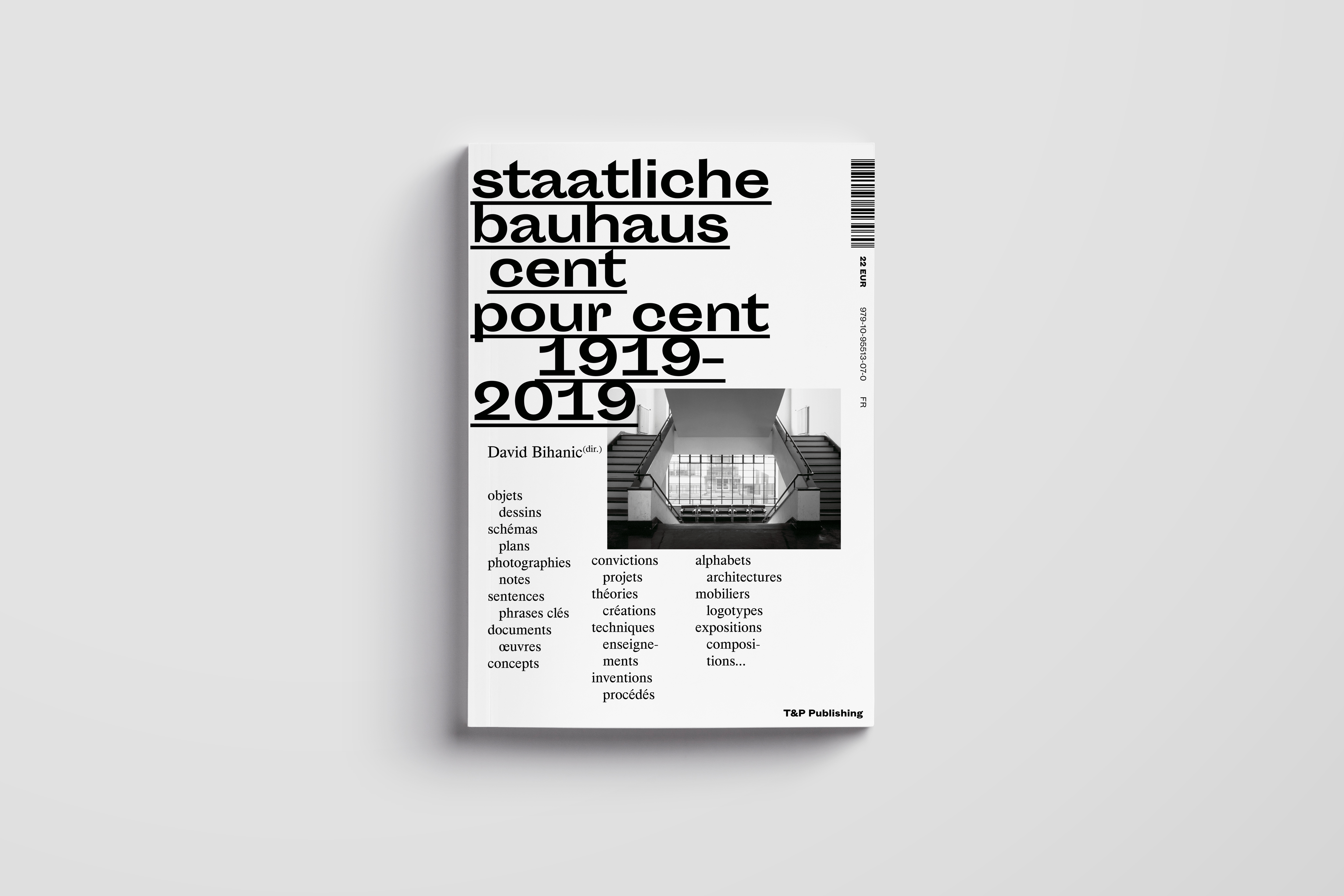
David Bihanic (dir.) (2019) staatliche bauhaus cent pour cent 1919-2019. T&P Publishing, Paris, 166 pages. Broché.
2019 : le bauhaus fondé et dirigé jusqu’en 1928 par l’architecte Walter Gropius a 100 ans. Plus qu’une école, ce fut un foyer, un centre d’où jaillirent des créations, des projets et des inventions, des théories, des conceptions et des idées neuves pour une vie résolument moderne. Autoritairement fermée, ses flammes s’aviveront outre-Atlantique, mais aussi dans les républiques soviétiques et jusqu’au Japon ou en Inde… Ses ‘animateurs’ pionniers comptent parmi les plus grands artistes du XXe siècle — Josef Albers, Herbert Bayer, Marcel Breuer, Wassily Kandinsky, Ludwig Mies van der Rohe, Hannes Meyer, Paul Klee, László Moholy-Nagy pour citer les plus illustres. Aujourd’hui encore, pas une école d’art, d’architecture, de design ou d’arts appliqués ne se forme ou se réforme sans y faire a minima référence. Filant ce précieux héritage, les courts textes proposés par 35 artistes, designers et théoriciens français, tous chercheurs, prélèvent et commentent. Ils forment une archive subjective et précise, qui déconstruit les ‘mythes’, soulève des questions, ouvre des pistes et permet de découvrir des aspects essentiels et parfois insolites de la période bauhaus et des années qui suivirent. Les images, parfois rares et peu connues, illustrent ou contribuent à former la sélection de 100 entrées : objets, dessins, plans et schémas, sentences et phrases clés, notes, documents et traces photographiques témoignent ensemble, de moments clés et également de manières de vivre et de penser.
2019: the bauhaus founded and directed until 1928 by the architect Walter Gropius celebrates its 100th year. More than a school, it was a ‘heart’, a‘center’ from which ‘sprang up’ creations, projects, inventions, theories, as well as new ideas for a firmly modern life. Forced to close, its ‘flames’ will grow across the Atlantic, but also in the Soviet republics as far as Japan or India… Its pioneer ‘animators’ are among the greatest artists of the twentieth century — to mention some of the most illustrious: Josef Albers, Herbert Bayer, Marcel Breuer, Wassily Kandinsky, Ludwig Mies van der Rohe, Hannes Meyer, Paul Klee, László Moholy-Nagy. Even today, every school of Art, Architecture and/or Design (likewise those devoted to Applied Arts), whether newly established and reformed, never avoid referring to the spirit of the bauhaus. Exploring this precious heritage, the short texts written by 35 French artists, designers and theoreticians, all researchers, take and comment. Taken together, they form a subjective and precise archive which deconstructs ‘myths’, raises questions, opens up avenues of reflexion and then allows to discover essential and every so often unusual aspects of the bauhaus period, and the years that followed. The images, sometimes rare or widely known, illustrate and occasionally contribute to form the selection of 100 entries: objects, drawings, plans and diagrams, sentences and key phrases, notes, documents and photographic traces, all of these ‘contents’ bear witness of certain key moments as well as special ways to live and think.
To order the book, click here. Only available in French.
List of authors:
• Alexandre Mare, Villa Noailles, Hyères, France,
• Alexandra Midal, “Haute École d’Art et de Design” (HEAD-Genève), Geneva, Switzerland
• Alice Savoie, University of Reading, England; ANRT, Nancy, France,
• Antonella Tufano, Paris La Villette National Higher School of Architecture, France,
• Brice Genre, A+B design studio; University of Toulouse Jean Jaurès, France,
• Building Paris (Guillaume Grall, Benoît Santiard), Graphic design studio, Paris; “École d’architecture de la ville & des territoires” in Marne-la-Vallée, France,
• Catherine Chomarat, University of Paris 1 Pantheon-Sorbonne, Paris, France,
• Catherine Geel, Nancy School of Art and Design; “École Normale Supérieure” in Cachan; Sciences-Po, Paris, France,
• Christophe Viart, University of Paris 1 Pantheon-Sorbonne, Paris, France,
• Clara Salomon, “École nationale supérieure des Beaux-Arts”, Paris, France,
• Claire Brunet, “École Normale Supérieure” in Cachan, France,
• David Bihanic, University of Paris 1 Pantheon-Sorbonne; “École nationale supérieure des Arts Décoratifs”, Paris, France,
• David Énon, “École supérieure d’art et de design” Tours-Angers-Le Mans, France
• Éléonore Challine, University of Paris 1 Pantheon-Sorbonne, Paris, France,
• Emanuele Quinz, University of Paris 8; “École nationale supérieure des Arts Décoratifs”, Paris, France,
• Erik Verhagen, Polytechnic University of Hauts-de-France, Valenciennes, France,
• François Perrodin, Regional School of Fine Arts of Rennes; Oniris art gallery, Rennes, France,
• Gwenaëlle Bertrand, Jean-Monnet University, Saint-Étienne, France,
• Jean-Louis Fréchin, Nodesign agency, Paris, France,
• Jocelyne Le Boeuf, “L’École de design Nantes Atlantique”, France,
• Pierre Litzler, University of Strasbourg, France,
• Maxime Favard, University of Strasbourg, France,
• Michel Le Belhomme, Binome art gallery, Paris, France,
• officeeabc (Brice Domingues, Catherine Guiral), Graphic design studio, Paris, France,
• Patricia Ribault, Humboldt University of Berlin, Germany,
• Pierre-Damien Huygue, University of Paris 1 Pantheon-Sorbonne, Paris, France,
• Philippe Million, Alain Gutharc art gallery, Paris, France,
• Ruedi Baur, “École nationale supérieure des Arts Décoratifs”, Paris, France; “Haute École d’Art et de Design” (HEAD-Genève), Geneva, Switzerland; University of Strasbourg, France,
• Stéphane Boudin-Lestienne, Villa Noailles, Hyères, France,
• Stéphane Dupont, independent graphic designer, Paris, France,
• Sophie Fétro, University of Paris 1 Pantheon-Sorbonne, Paris, France,
• Thierry Chancogne, founder of t-o-m-b-o-l-o.eu editions and Ravisius Textor space, Nevers, France.
©T&P Work Unit—T&P Publishing, Paris 2019
D. Bihanic (sous la dir.), staatliche bauhaus cent pour cent 1919-2019
148 × 210 mm
ISBN 979-10-95513-07-0
EAN 9791095513070
[Book] Design en regards
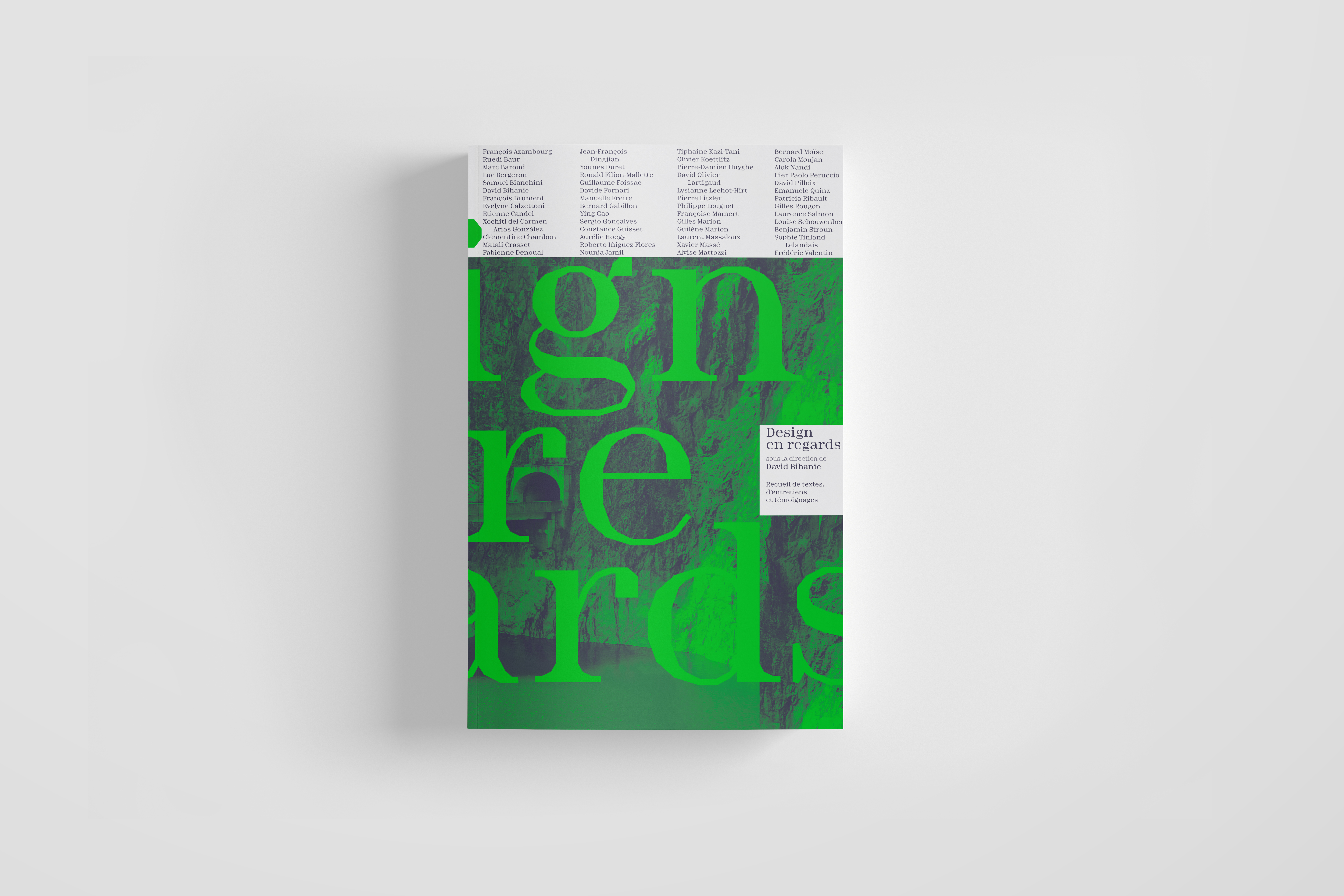
David Bihanic (dir.) (2019) Design en regards. Art Book Magazine (ABM)—EnsAD—La Cité du design, Paris/Saint-Étienne, 497 pages. Broché.
Qu’y aurait-il de foncièrement changé aujourd’hui dans la manière moins, peut-être, de transmettre le design (son histoire, sa culture, sa théorie) que de former au design ? — selon l’acception jadis retenue notamment par Johannes Itten et Walter Gropius touchant à l’intériorité de l’être, à son accomplissement et ne se rapportant nullement ici au formatage de l’esprit, au dressage ou conditionnement de l’action ; former (ou, symétriquement, se former) au design ne serait autre, en l’espèce, que viser (ou convoiter) l’accès aux ‘savoir-penser’ et ‘savoir-créer’ conjugués permettant l’approfondissement de la subjectivité et favorisant la construction d’une conscience aussi éclairée que libre. Autour de cette question complexe, mais du reste essentielle, plusieurs acteurs francophones de l’enseignement du design ici réunis partagent leurs regards, leurs convictions et réflexions, tentant ainsi d’y apporter certains éléments de réponse.
To what may the difference in how Design is taught be attributed today? The fundamentals of its teachings are in a state of relative upheaval, and the trend seems to be moving gradually away from an approach rooted in the one-way transmission of its history, culture and theory, and more closely towards one rooted in mutual learning and practice. Johannes Itten and Walter Gropius firmly believed that Design Education was closely tied to the evolution of the inner being and the accomplishments related thereto, and was, in no way, to be a hindrance to the creative process or potential. For others, though, the field is the sole means to knowledge acquisition through the pooling of both think-how and design-how, enabling greater subjectivity and fostering an enlightened and free conscientiousness. The texts gathered in this volume attest to the diversity of myriad players in the French-speaking community of Design Teaching, and attempt to shed light on a question that is not only complex, but also crucial.
To find out more, visit the book page on lespressesdureel.com. To order the book, click here. Only available in French.
©ABM—EnsAD—La Cité du design Paris/Saint-Étienne 2019
D. Bihanic (sous la dir.), Design en regards
155 × 240 mm
ISBN 978-2-8216-0115-4
EAN 9782821601154
List of authors:
• François Azambourg, École Nationale Supérieure de Création Industrielle (ENSCI-Les-Ateliers), Paris, France; Studio François Azambourg, Paris, France,
• Ruedi Baur, École nationale supérieure des Arts Décoratifs (EnsAD), Paris, France; Haute École d’Art et de Design (HEAD-Genève), Geneva, Switzerland; Université de Strasbourg, France; Agence Intégral Ruedi Baur (Paris, France; Zurich, Suisse),
• Marc Baroud, Académie Libanaise des Beaux-Arts (ALBA), Beyrouth, Lebanon; Studio Marc Baroud, Paris, France,
• Luc Bergeron, École Cantonale d’Art de Lausanne (ECAL), Renens―Lausanne, Suisse,
• Samuel Bianchini, École nationale supérieure des Arts Décoratifs (EnsAD), Paris, France,
• David Bihanic, Université Paris 1 Panthéon-Sorbonne, France; École nationale supérieure des Arts Décoratifs (EnsAD), Paris, France,
• Sylvain Bourmeau, Radio France Culture, Journal AOC (Analyse—Opinion—Critique), Paris, France,
• François Brument, École Supérieure d’Art et de Design de Saint-Étienne (ESADSE), France; Studio In-flexions, Paris, France,
• Evelyne Calzettoni, École Supérieure d’Arts Appliqués (ESAA)—La Martinière Diderot, Lyon, France,
• Étienne Candel, Université de Lyon 3, France,
• Xochitl del Carmen Arias González, Université technologique de Monterrey, Mexique,
• Clémentine Chambon, École Nationale Supérieure de Création Industrielle (ENSCI-Les-Ateliers), Paris, France; Studio Clémentine Chambon, Paris, France,
• Matali Crasset, École Nationale Supérieure (ENS), Cachan; Agence Matali Crasset Productions, Paris, France,
• Fabienne Denoual, Université de Toulouse Jean Jaurès, Toulouse, France,
• Jean-François Dingjian, École Nationale Supérieure de Création Industrielle (ENSCI-Les-Ateliers), Paris, France; Agence Normal Studio, Paris, France,
• Younes Duret, École Supérieure d’Arts Appliqués et de Design (ESAAD), Casablanca, Marocco; Studio Younes Duret Design, Marrakech, Maroc,
• Ronald Filion-Mallette, École de design de l’Université du Québec à Montréal (UQUAM), Québec,
• Guillaume Foissac, EDF R&D—design, Paris; École Nationale Supérieure de Création Industrielle (ENSCI-Les-Ateliers), Paris, France,
• Davide Fornari, École Cantonale d’Art de Lausanne (ECAL), Renens―Lausanne, Suisse,
• Manuelle Freire, École nationale supérieure des Arts Décoratifs (EnsAD), Paris, France; Université Concordia, Montréal, Québec,
• Bernard Gabillon, École Supérieure des Arts Appliqués et du Textile (ESAAT), Roubaix, France,
• Ying Gao, École de design de l’Université du Québec à Montréal (UQUAM), Quebec; Studio Ying Gao, Montréal, Québec,
• Sergio Gonçalves, Institut polytechnique de Leiria, École Supérieure d’Arts et de Design (ESAD), Portugal,
• Constance Guisset, Studio Constance Guisset, Paris, France,
• Aurélie Hoegy, Design Academy Eindhoven, Pays-Bas,
• Roberto Iñiguez Flores, Université technologique de Monterrey, Mexique,
• Nounja Jamil, École Supérieure des Arts Appliqués (ESAA) Duperré, Paris, France; Studio Tovo+Jamil, Paris, France,
• Tiphaine Kazi-Tani, Télécom ParisTech, Paris, France,
• Olivier Koettlitz, École Supérieure des Arts Appliqués et du Textile (ESAAT), Roubaix, France,
• Pierre-Damien Huyghe, Université Paris 1 Panthéon-Sorbonne, France,
• David-Olivier Lartigaud, École Supérieure d’Art et de Design de Saint-Étienne (ESADSE), France,
• Lysianne Lechot-Hirt, Haute École d’Art et de Design (HEAD-Genève), Geneva, Suisse,
• Pierre Litzler, Université de Strasbourg, France,
• Philippe Louguet, École Nationale Supérieure d’Architecture et de Paysage de Lille (ENSAPL), France,
• Françoise Mamert, École Supérieure des Arts Appliqués (ESAA) Duperré, Paris, France; Agence Design Percept, Paris, France,
• Gilles Marion, École Supérieure d’Arts Appliqués (ESAA)—La Martinière Diderot, Lyon, France,
• Guilène Marion, École Supérieure d’Arts Appliqués (ESAA)—La Martinière Diderot, Lyon, France,
• Laurent Massaloux, École Nationale Supérieure de Création Industrielle (ENSCI-Les-Ateliers), Paris, France; Studio Laurent Massaloux, Paris, France,
• Xavier Massé, Société M, Toronto, Canada,
• Alvise Mattozzi, Université libre de Bozen-Bolzano, Italie,
• Bernard Moïse, École Nationale Supérieure de Création Industrielle (ENSCI-Les-Ateliers), Paris, France; Centre Michel Serres, Paris, France; Agence Moïse Studio, Marseille, France,
• Carola Moujan, École Camando—Les Arts Décoratifs, Paris, France; École Supérieure des Beaux-Arts Tours-Angers-LeMans (TALM), Tours, France,
• Alok Nandi, Institut Paul Bocuse, Paris, France; Interaction Design Association (IxDA), Beaverton, États-Unis,
• Pier Paolo Peruccio, École polytechnique de Turin, Italie,
• David Pilloix, École Supérieure d’Arts Appliqués (ESAA)—La Martinière Diderot, Lyon, France,
• Emanuele Quinz, Université Paris 8 Saint-Denis, France; École nationale supérieure des Arts Décoratifs (EnsAD), Paris, France,
• Patricia Ribault, Université Humboldt de Berlin, Allemagne,
• Gilles Rougon, World Design Organization, Montréal, Quebec; EDF Innovation Hub, Paris, France,
• Laurence Salmon, École Supérieure d’Art et de Design (ESAD), Orléans, France,
• Louise Schouwenberg, Design Academy Eindhoven, Pays-Bas,
• Benjamin Stroun, Haute École d’Art et de Design (HEAD-Genève), Suisse,
• Emmanuel Tibloux, École nationale supérieure des Arts Décoratifs (EnsAD), Paris, France,
• Sophie Tinland Lelandais, École Supérieure d’Arts Appliqués (ESAA)—La Martinière Diderot, Lyon, France,
• Frédéric Valentin, Télécom ParisTech, Paris, France.
[Book] Data Design. Les données comme materiau de création
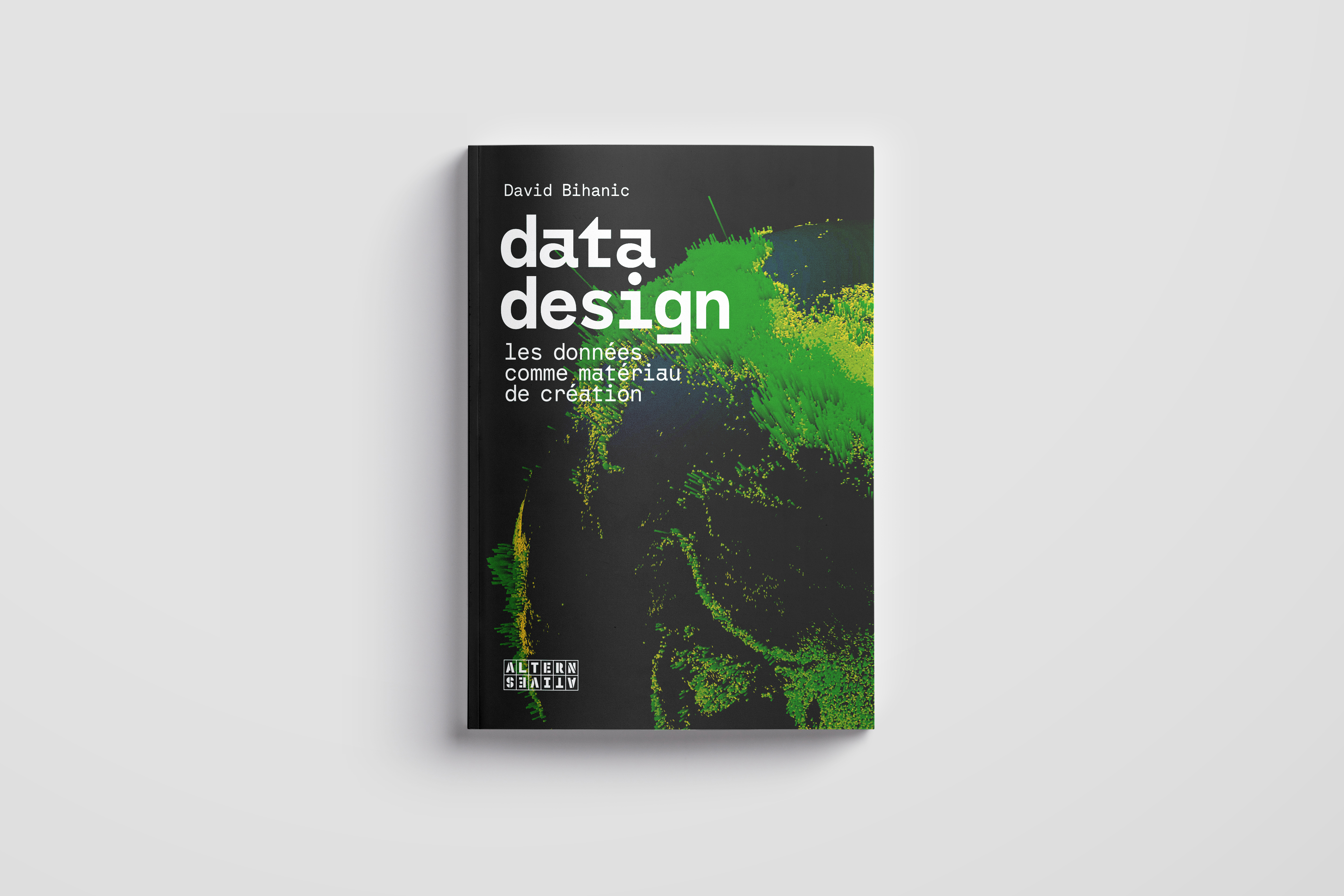
David Bihanic (2018) Data Design. Les données comme materiau de création. Gallimard, coll. Alternatives, Paris, 76 pages. Relié integra.
This book is only available in French (at least for now). Translation in English of the book title: Data Design. The Data as a Creative Medium
Book Cover: ©Jan Willem Tulp, Trillions of Trees.
Par certains aspects (pratiques, techniques principalement), la profusion actuelle de données est un problème dont la résolution, manifestement complexe, appelle une contribution et un effort soutenus d’experts de nombreuses sections disciplinaires. Par d’autres côtés et points de vue, ces monceaux de données s’élevant chaque jour un peu plus constituent une véritable fortune dont plusieurs s’accordent à dire qu’elle composera bientôt le ‘lit’, le terreau ou substrat d’une appréhension et compréhension renouvelées du monde contemporain et de ses affairements. Non loin des scientifiques, des ingénieurs notamment, les designers de données (‘data designers’) entendent prendre leur part du travail. Moins directement préoccupés ou plutôt empêchés par les obstacles techniques, ils se proposent d’avancer en éclaireurs, en explorateurs de ce nouveau monde. Retirant de leurs aventures créatives autant en discernement qu’en acuité sur la valeur qu’il convient d’attacher aux données, ces designers réussissent dès lors à prouver qu’il y a plus souvent lieu de se réjouir de leur foisonnement que de regretter les désagréments et méfaits qu’il nous en coûte. Ce livre, dont la forme à multiples dépliants encourage la surprise et la déambulation, présente l’extraordinaire diversité des médiums et des pratiques de data design : objets, sculptures, installations, infographies, visualisations interactives, etc. L’ensemble des productions ici rassemblées met en lumière le caractère immatériel des données et leur immanente présence.
To find out more, visit the book page on gallimard.fr. To order the book, click here.
©Gallimard-Zanardi Paris 2018
D. Bihanic, Data Design. Les données comme matériau de création
150 × 200 mm
ISBN 978-2-0727-9200-7
Gencode 9782072792007
Code distributeur G01952
Endorsement:
“This book features a beautiful exposition of well-crafted digital and tangible data art work. A must for people looking for new visual metaphors to communicate insights and stories from data.”
– Nicolás García Belmonte,
Head of Visualization engineering at Uber.
“Data not seem natural to us but in some ways they actually govern the present world. The main virtue of the David Bihanic’s book is to clearly show that the images, in particular — and other materials produced by design — as well as their poetic action are powerful vectors for a better understanding of our complex and a priori arid world of today. It is beyond any doubt that such approach is essential to allow people following the technological advancements and, in return, to make technologies truly more human.”
– Gilles Babinet,
Entrepreneuriat and Digital Champion (European Commission).
“Today, digital design opens things up to endless possibilities, frightening to some, exhilarating for others. It plays a key role in forging the today’s — and tomorrow’s — world. This book exposes some of its last explorations, creations and inventions at a time of an amazing data flood. The author perfectly demonstrates how design succeeds to transform data in information, information to knowledge, and sometimes in pieces of poetry. All those fascinating topics are intelligently shared in this excellently-illustrated volume.”
– Jean-Louis Fréchin,
Designer and CEO of NoDesign studio.
[Book] New Challenges for Data Design

David Bihanic (ed.) (2015) New Challenges for Data Design. Springer, London, 447 pages. Hardcover.
This book provides a platform for leading Data designers whose vision and creativity help us to anticipate major changes occurring in the Data Design field, and pre-empt the future. Each of them strives to provide new answers to the question, “What challenges await Data Design?” To avoid falling into too narrow a mind-set, each works hard to elucidate the breadth of Data Design today and to demonstrate its widespread application across a variety of business sectors. With end users in mind, designer-contributors bring to light the myriad of purposes for which the field was originally intended, forging the bond even further between Data Design and the aims and intentions of those who contribute to it. The first seven parts of the book outline the scope of Data Design, and presents a line-up of “viewpoints” that highlight this discipline’s main topics, and offers an in-depth look into practices boasting both foresight and imagination. The eighth and final part features a series of interviews with Data designers and artists whose methods embody originality and marked singularity. As a result, a number of enlightening concepts and bright ideas unfold within the confines of this book to help dispel the thick fog around this new and still relatively unknown discipline. A plethora of equally eye-opening and edifying new terms, words, and key expressions also unfurl. Informing, influencing, and inspiring are just a few of the buzz words belonging to an initiative that is, first and foremost, a creative one, not to mention the possibility to discern the ever-changing and naturally complex nature of today’s datasphere. Providing an invaluable and cutting-edge resource for design researchers, this work is also intended for students, professionals and practitioners involved in Data Design, Interaction Design, Digital & Media Design, Data & Information Visualization, Computer Science and Engineering.
List of authors:
• Ali Almossawi Mozilla Corporation, San Francisco, CA, USA,
• David Bihanic CALHISTE Laboratory, University of Valenciennes and Hainaut-Cambresis, Valenciennes, France,
• Rachel Binx Walnut, CA, USA,
• Arlene Birt Background Stories, Ames, IA, USA,
• Alberto Cairo University of Miami, Coral Gables, FL, USA,
• Andy Cameron New York, NY, USA
• Giorgio Caviglia Stanford University, Stanford, CA, USA,
• Dino Citraro Periscopic, Portland, OR, USA,
• Nicholas Felton New York, NY, USA,
• Steffen Fiedler Studio NAND, Berlin, Germany,
• Fabien Girardin Near Future Laboratory, Sierre, Switzerland,
• Wesley Grubbs Pitch Interactive, Berkeley, CA, USA,
• Jonathan Harris New York, NY, USA,
• Sha Hwang Walnut, CA, USA,
• Jonas Loh Studio NAND, Berlin, Germany,
• Giorgia Lupi Accurat, New York, NY, USA,
• Pablo Martínez-Díez Tech (UPC), Barcelona, Spain; BAU Design College of Barcelona, Universitat de Vic (UVIC), Barcelona, Spain,
• Scott Murray University of San Francisco (USF), San Francisco, CA, USA,
• Santiago Ortiz Moebio, Buenos Aires, Argentina,
• Stefanie Posavec London, UK,
• Kim Rees Periscopic, Portland, OR, USA,
• Mar Santamaria-Varas School of Architecture of Barcelona (ETSAB), [SP] Universitat Politècnica de Catalunya, Barcelona, Spain,
• Moritz Stefaner Lilienthal, Germany,
• Stephan Thiel Studio NAND, Berlin, Germany,
• Jan Willem Tulp TULP Interactive, The Hague, The Netherlands,
• Giorgio Uboldi Politecnico di Milano, Milan, Italy,
• Richard Vijgen Richard Vijgen Studio, GT, Arnhem, The Netherlands,
• Christopher Warnow Wuerzburg, Bavaria, Germany,
• Benjamin Wiederkehr Interactive Things, Zürich, Switzerland,
• Ben Willers Lincoln, UK.
To find out more, visit the book page on springer.com.
Click here to consult the table of contents.
Click here to read the preface.
To order the book, click here.
©Springer-Verlag London 2015
D. Bihanic (ed.), New Challenges for Data Design
DOI 10.1007/978-1-4471-6596-5_1
ISBN 978-1-4471-6595-8
ISBN 978-1-4471-6596-5 (eBook)
Endorsement:
“Data design is the most important new cultural field of out time, and now its finally has its define book. It collects articles by who is who in data design around the world. For the first time, many of these leading designers articulated in details their ideas, methods and experiences gained from working on their award winning projects. If you already working with data as a designer, programmer, teacher, or researcher, or just thinking about getting into data analysis and visualization, you must read this book.”
– Dr. Lev Manovitch,
Professor, The Graduate Center, City University of New York (CUNY);
Director, Software Studies Initiative softwarestudies.com
[Book] Empowering Users through Design (…)

David Bihanic (ed.) (2015) Empowering Users through Design. Interdisciplinary Studies and Combined Approaches for Technological Products and Services. Springer, Cham (Switzerland), 284 pages. Hardcover.
At the crossroads of various disciplines, this collective work examines the possibility of a new end-user “engagement” in ongoing digital/technological products and services development. It provides an overview of recent research specifically focused on the user’s democratic participation and empowerment. It also enables readers to better identify the main opportunities of participatory design, a concept which encourages the blurring of the role between user and designer. This allows people to escape their status as “end-user” and to elevate themselves to the level of creator. This book explores new avenues for rethinking the processes and practices of corporate innovation in order to cope with current socio-economic and technological changes. In so doing, it aims to help companies renew industrial models that allow them to design and produce new ranges of technological products and services by giving the user an active role in the development process, far beyond the basic role of consumer. Intended for designers, design researchers and scientists interested in innovation and technology management, this book also provides a valuable resource for professionals involved in technology-based innovation processes.
List of authors:
• Liapis Aggelos Intrasoft International SA, Luxembourg, Luxembourg,
• Gabriela Avram Interaction Design Centre, University of Limerick, Limerick, Ireland,
• Samuel Bianchini EnsadLab-Reflective Interaction, The École Nationale Supérieure Des Arts Décoratifs, Paris, France,
• David Bihanic CALHISTE Laboratory, University of Valenciennes and Hainaut-Cambresis, Valenciennes, France,
• Rémy Bourganel EnsadLab-Sociable Media, The École Nationale Supérieure Des Arts Décoratifs, Paris, France,
• Serena Cangiano Laboratory of Visual Culture, SUPSI, Canobbio, Switzerland,
• Flaviano Celaschi University of Bologna, Bologna, Italy,
• Manuela Celi Politecnico di Milano, Dipartimento di Design, Milan, Italy,
• Luigina Ciolfi C3RI, Sheffield Hallam University, Sheffield, UK,
• Samuel Gantier DeVisu Laboratory, University of Valenciennes and Hainaut-Cambresis, Valenciennes, France,
• Annie Gentès Codesign Lab, Chair Design Theory and Methods for Innovation, Telecom ParisTech, Paris, France,
• Carole Gray Norwich University of the Arts, Norwich, UK,
• Pierre-Damien Huyghe University of Paris I Pantheon-Sorbonne, Paris, France,
• Ilpo Koskinen The Department of Design, School of Arts, Design and Architecture, Aalto University, Aalto, Finland,
• Michel Labour DeVisu Laboratory, University of Valenciennes and Hainaut-Cambresis, Valenciennes, France,
• Florent Levillain University of Paris 8 Vincennes-Saint-Denis, Saint-Denis, France; The École Pratique Des Hautes études (EPHE), Paris, France; The Cité Des Sciences et de L’industrie, Paris, France,
• Julian Malins Norwich University of the Arts, Norwich, UK,
• Fiona McDermott Interaction Design Centre, University of Limerick, Limerick, Ireland,
• Massimo Menichinelli Media Lab Helsinki, Department of Media, School of Art, Design and Architecture, Aalto University, Aalto, Finland,
• Max Mollon EnsadLab-Sociable Media, École Nationale Supérieure des Arts Décoratifs, Paris, France,
• Nicolas Nova HEAD—Genève, Geneva, Switzerland,
• Jon Pengelly Gray’s School of Art, Robert Gordon University, Aberdeen, Scotland,
• Daniela Petrelli C3RI, Sheffield Hallam University, Sheffield, UK,
• Emanuele Quinz EnsadLab-Reflective Interaction, The École Nationale Supérieure Des Arts Décoratifs, Paris, France; University of Paris 8 Vincennes-Saint-Denis, Saint-Denis, France,
• Zoe Romano WeMake, Milan’s Makerspace, Milan, Italy,
• Jennifer Rudkin Politecnico di Milano, Dipartimento di Design, Milan, Italy,
• Cristiano Storni Department of Computer Science and Information Systems, Interaction Design Centre, University of Limerick, Limerick, Ireland,
• Dick van Dijk Waag Society, Amsterdam, The Netherlands,
• Theodora Vardouli Massachusetts Institute of Technology, Cambridge, MA, USA,
• Jack Whalen The Department of Design, School of Arts, Design and Architecture, Aalto University, Aalto, Finland,
• Yiying Wu The Department of Design, School of Arts, Design and Architecture, Aalto University, Aalto, Finland,
• Elisabetta Zibetti University of Paris 8 Vincennes-Saint-Denis, Saint-Denis, France; The École Pratique Des Hautes études (EPHE), Paris, France; The Cité Des Sciences et de L’industrie, Paris, France.
To find out more, visit the book page on springer.com.
Click here to consult the table of contents.
Click here to read the preface.
To order the book, click here.
©Springer International Publishing Switzerland 2015
D. Bihanic (ed.), Empowering Users through Design
DOI 10.1007/978-3-319-13018-7_1
ISBN 978-3-319-13017-0
ISBN 978-3-319-13018-7 (eBook)
An important part of my research is mostly concerned with digital-UI-interaction-data design, data visualization aesthetics and creative informatics. This work spans the whole spectrum, from theory to implementation techniques and applications.
Others publications edited
May 2016: Co-editor (with Sophie Dupuy-Chessa, Xavier Le Pallec, and Thomas Polacsek) of the special issue (vol. 35/2) of the French Scientific and Technical Review “Techniques et Sciences Informatiques” (TSI) entitled: “Visualization and manipulation of complex models.”
December 2015: Co-editor (with Philippe Gauthier from the University of Montreal) of the second issue of the scientific journal “Sciences du Design” published by PUF (“Presses Universitaires de France”) entitled: “Practices and discourses” (thematic focus).
Count of publications, keynotes, projects, public demos, and exhibitions since 1999
. 29 journal papers and conference publications,
. 13 book chapters,
. 15 magazines papers,
. 2 reports on scientific research (related to software design),
. 37 lectures (keynote, plenary, and distinguished lectures),
. 1 patent (international patent issue),
. 22 design projects (digital and data design),
. 6 exhibitions, and public demonstrations/presentations.
Publications (book chapters, articles, etc.), invited lectures, and conference presentations (selection)
To be published in August 2018: David Bihanic, Of the research pratice, “De la pratique en recherche”, Chapter in the collective book entitled “De l’atelier au labo”/”From the studio to the lab”. Hermann Editions, Paris.
David Bihanic, Julie Ackermann, Art and Big Data: how to represent the data deluge?, “Art et Big Data : comment représenter la déferlante des données ?”, Interview published in Les Inrockuptibles magazine, June, 12, 2018. URL: www.lesinrocks.com[…]
David Bihanic, Products without quality, “Produits sans qualités”, article published in the french journal entitled AOC (Analyse, Opinion, Critics) directed by the journalist Sylvain Bourmeau, May 4, 2018. URL: aoc.media[…]
David Bihanic, The scientific statement format in art and design, Lecture at the two-day conference entitled “Nous ne sommes pas le nombre que nous croyons être”/“We are not the number we believe to be” round-table dedicated to Art and Design research publications with the participation of the following other lecturers: Lucile Haute, Julie Blanc, Anthony Masure, Robin de Mourat, Vincent Piccolo, Annick Rivoire and Nolwenn Tréhondart) organised by the Daniel & Nina Carasso Foundation in partnership with the “École Polytechnique”, the “École Nationale Supérieure des Arts Décoratifs”, and the “Cité internationale des Arts”, February 2-3, 2018, “Cité internationale des Arts”, Paris.
Oussama Mubarak, Pierre Cubaud, David Bihanic, Samuel Bianchini, Designing Collaborative Co-Located Interaction for an Artistic Installation. In proceedings of the 16th IFIP TC 13 International Conference (INTERACT 2017, Human-Computer Interaction), September 25–29, 2017, Mumbai, India.
Oussama Mubarak, David Bihanic, Pierre Cubaud, Samuel Bianchini, Art installations: a study of the topology of collective co-located interactions. In proceedings of the 8th International Conference on Digital Arts (ARTECH 2017), September 6-8, 2017 Macau, China.
Invited to take part in the radio program (directed by Sylvain Bourmeau) entitled “La suite dans les idées” broadcast on France Culture, November, 11, 2017. URL (podcast): www.franceculture.fr[…]
David Bihanic, Discrepancies in Work Time (The major OECD countries), “Durée du temps de travail dans les principaux pays de l’OCDE”, Published in the french scientific news magazine ‘Pour La Science’‘: “Données à voir : Travailler plus pour ne pas gagner plus”, September-August, 2017, N° 96, pp. 114-115. URL: www.pourlascience.fr[…]
David Bihanic, Discrepancies in Work Time (The major OECD countries), “Durée du temps de travail dans les principaux pays de l’OCDE”, “Sciences du Design” 1/2017 (n° 5), PUF, Paris, pp. 22-27. URL : www.cairn.info[…] (published online January, 2017).
Aurélie Daanen, David Bihanic, Geneviève Filipi, François Palaci, Gilles Rourgon, Pascal Salembier, Ergonomics and Design: cross scientific expertise on the characterization of information production and sharing experience in complex industrial environments, “Design & Ergonomie: du partage d’expertise pour une caractérisation de l’expérience de production et d’échange de l’information en environnement complexe”, Lecture at the World Design Summit (WDS), October 16-25 2017, Montreal Montreal, Quebec/Canada.
David Bihanic, Deadly crossings to Europe, Conference “Where to find refuge today?”, 25-year Symposium of the NGO SIF (an international Non Governmental solidarity Organization acting in the fields of humanitarian and development aid, in France and worldwide), Musée des confluences, May 17, 2017, Lyon.
David Bihanic, Memories of Deportations, “Mémoires des déportations”, Testimonies of deportees — Nazi concentration camps and killing centers of European Jewry, produced and directed by “l’Union des Déportés d’Auschwitz ” (UDA) with the support of “la Fondation pour la Mémoire de la Shoah”, “l’Institut National de l’Audiovisuel” (INA), “la Mairie de Paris” (The City Hall of Paris) and “la Direction de la Mémoire, du Patrimoine et des Archives” (DMPA) of the department of National Defence.
David Bihanic, Deadly crossings to Europe, Conference “Data Publics: Investigating the formation and representation of crowds, groups and clusters in digital economies” at Lancaster University, 31st March-2nd April, 2017 organized by Clara Crivellaro (Newcastle University), Joe Deville (Lancaster University), Daniel Richards (Lancaster University), Sebastian Weise (Newcastle University), and Louise Mullagh (Lancaster University / conference coordination and exhibition curation).
David Bihanic, Discrepancies in Work Time (The major OECD countries), “Durée du temps de travail dans les principaux pays de l’OCDE”, Data visualization published in the newspaper Ouest France: Julie Cateau, “Infographie. Présidentielle: les Français travaillent-ils assez ?”, April 12 2017 (10h19). URL: www.ouest-france.fr[…]
David Bihanic, Research practice, practice-based research, “Pratique de la recherche, recherche par la pratique”, Lecture at the Cité du Design (auditorium) during the 2017 International Design Biennial, Saint-Etienne (France), “Journée de présentation de la rénovation de la filière Design & Métiers d’art”, March 29 mars 2017.
David BIHANIC, Flashback on a data visualization project: Deadly crossings to Europe, Meetings AFK #9, Le Tank (co-working space supported by the region Islands France), March 22, 2017, Paris.
Aurélie Daanen, David Bihanic, Geneviève Filipi, Gilles Rougon, Pascal Salembier, Ergonomics and Design: cross scientific expertise, “Ergonomie et design : partage d’expertise de la conception”, Conference “La conception d’un artefact: approches ergonomiques et didactiques”, October 6-7 2016, Haute Ecole Pédagogique in the Canton of Vaud, Lausanne, Switzerland. Proceedings published as a book by the UTBM academic press (University of Technology of Belfort-Montbéliard — Northeastern France) and Alphil Editions.
Oussama Mubarak, David Bihanic, Samuel Bianchini, Artistic devices and installations: a study of the topology of collective co-located interactions, “Dispositifs & installations artistiques : étude de la topologie des interactions collectives co-localisées”, IHM Conference (IHM’16) (28th edition) — Francophone Conference on HCI, October 25-28, 2016, Fribourg, Switzerland.
David Bihanic, Thibault Jaillon, Data Shapes, Information++ Conference — Information Everything, June 6-July 3, 2016, Emily Carr University of Art + Design, Vancouver, BC, Canada. In partnership with International Information Design Association (IDA), the Information Design Journal (IDJ), the International Institute for Information Design (IIID), and the sociedade brasileira de design da informação (sbdi). URL: www.informationplus[…]
**Thibault Jaillon (coauthor) is a software engineer, founder and CEO of “SquareGlasses” (web agency).**
David Bihanic, Deadly crossings to Europe: Refugees crossing Mediterranean (2000-2016). This webmap project obtained the recommendation of the International Organization for Migration (IOM), 2016.
David Bihanic, Flood vs Drought. Infographics, 2016.
David Bihanic, Migrant remittances from France. Infographics, 2016.
David Bihanic, The series lies within in objects (keynote), “La série est dans l’objet”, 6th International Forum of Design as a Process — Systems and Design, June 22-24 2016, Universitat Politècnica de València, Spain. In partnership with Latin Network for the development of Design Processes.
David Bihanic, The digital pollution, “La pollution numérique”, “Sciences du Design” 1/2016 (n° 3), PUF, Paris, pp. 22-25. URL: www.cairn.info[…] (published online June, 2016).
David Bihanic, Numbers in colors: the use of color in Data Design, “Données en couleurs: de l’emploi de l’attribut couleur en data design”, Study day entitled “About Color — objectivity”, organized by the “Haute École des Arts du Rhin” (HEAR), MESHS et iCAVS — Interdisciplinary Cluster for the Advancement of Visual Studies. Affiliated research laboratories: CEAC (EA 3587), GERIICO (EA 4073), IRHIS (UMR 8529), Painlevé laboratory (UMR 8524), LIFL (EA 4491), LISIC (EA 4491), STL (UMR 8163), URECA (EA 1059), MESHS (USR 3185) — Proceedings published as a book by –zeug editions and the “Haute École des Arts du Rhin” (HEAR), June 2016.
David Bihanic, The role of Practice in Research, “De la pratique en recherche”, Study day entitled “Research and Creation”, University of Valenciennes and Hainaut-Cambresis/CALHISTE Laboratory (EA 4343), Valenciennes, April 2-3 2015. Proceedings published as a book by Hermann editions (book editor: Catherine Chomarat-Ruiz), 2016.
David Bihanic, Thomas Polacsek, StrataVis: a new model-oriented visualization technique, “StrataVis : une technique de visualisation graphique orientée modèle”, Computer Sciences and Techniques (“Techniques et Sciences Informatiques” — TSI), Special Issue “Visualization and manipulation of complex models” (edited by David Bihanic, Sophie Dupuy-Chessa, Xavier Le Pallec, and Thomas Polacsek), Hermes-Lavoisier edition press, Paris, May 2016.
David Bihanic, The global innovation race, “La course à l’innovation”, “Sciences du Design” 2/2015 (n° 2), PUF, Paris, p. 11-14. URL: www.cairn.info[…] (published online December, 2015).
David Bihanic, When sounds become forms, “Quand les sons deviennent formes”, Étape (international design magazine), N°226 (july-august 2015), Pyramid Edition, Paris, pp. 106-108.
David Bihanic, Interview with Ben Willers for infogr8 (based in London ). Trend Report Spring 2015 — Data Led Content. URL: infogr8.com[…] (published online March 26, 2015).
David Bihanic, Corinne Beck, CALHISTE Laboratory: an institutional research model promoting interdisciplinarity, “CALHISTE: modèle de la transversalité pour une recherche en Arts/Lettres et SHS”, “Matinée des chercheurs 2015” (MdC’2015), University of Mons (Belgium), Polytechnic Faculty in Mons, March 10 2015.
David Bihanic, Giving Shape to Data, in New Challenges for Data Design, Springer, London, Chapter 2, pp. 23-53.
David Bihanic, Pierre-Damien Huyghe, Form Follows Practice, in Empowering Users through Design. Interdisciplinary Studies and Combined Approaches for Technological Products and Services, Springer, Cham, Chapiter 1, pp. 1-13.
David BIHANIC, Introduction to RES conference (research in data visualization), Opening day of MESHS research program “Work and Creation”, November 6 2014, Lille.
David Bihanic, Data Design, “Du design de données (data design)”, IHM Conference (IHM’14) (26th edition) — Francophone Conference on HCI, October 28-31 2014, Lille.
David Bihanic, Applied Research in Design, “De la recherche en projets”, Theme days entitled “Design Research, a challenge for the new University of Paris-Saclay” organized by Claire Brunet, the “École Normale Superieure Cachan”, October 15-16 2014, Cachan.
David Bihanic, Designing data flow: a conceptual framework for the analysis of new data flow visualization models, “Design de grands flux de données. Cadre conceptuel d’analyse esthétique cognitive des modèles ‘non-conventionnels’ de représentation-visualisation de données”, Computer Sciences and Techniques (“Techniques et Sciences Informatiques” — TSI), Special Issue “Visualizing Massive Data” (edited by Jean Daniel Fekete and Pierre Dragicevic), Hermes-Lavoisier edition press, Paris, September 2014, pp. 499-539.
David Bihanic, Sophie Dupuy-Chessa, Xavier Le Pallec, Thierry Morineau, Thomas Polacsek, Visualization and manipulation of complex models, “Manipulation et visualisation de modèles complexes”, National days of the GdR GPL research group (6th edition), Session “Challenges in Software Engineering for 2025”, June 11-13 2014, CNAM, pp. 183-187.
David Bihanic, Research in Data Design, Research cycle called “Petits déjeuners valorisation” organized by MESHS — conference session entitled “Copyright Matters in Research” (“Le droit d’auteur au service de la recherche”) directed by Anne-Laure Stérin, December 19 2014, MESHS, Lille.
David Bihanic, A l’avant-garde! Graphic Design in the digital era, “À l’avant-garde ! Du Design graphique à l’heure du numérique”, Étapes (international design magazine), N°215 (july-august 2013), Pyramid Edition, Paris, pp. 100-103.
David Bihanic, Schizoid Architecture: interview with François Roche, L’ARCA International (international magazine devoted to Architecture, design and visual communication — published in three languages: French/Italian/English), N°113 (july-august 2013), M.D.O. Editions, Monaco, pp. 66-75.
David Bihanic, Crossover design: the cross-cutting approach to creation, “Crossover design. Transversalité et quête du style”, Étapes (international design magazine), N°212 (march-april 2013), Pyramid Edition, Paris, pp. 211-215.
David Bihanic, Max Chevalier, Sophie Dupuy-Chessa, Xavier Le Pallec, Thierry Morineau, Thomas Polacsek. Graphical modeling of information systems: visual processing of complex models, “Modélisation graphique des SI : Du traitement visuel de modèles complexes”, May 29-31 2013, INFORSID’2013 (31th Congress), University of Paris I Pantheon-Sorbonne.
David Bihanic, Shape It Yourself! the promise of creative emancipation, “Shape It Yourself! La promesse d’une émancipation créative”, Étapes (international design magazine), N°201 (november-december 2012), Pyramid Edition, Paris.
David Bihanic, Thomas Polacsek, Models for visualisation of Complex Information Systems. In Proceedings of the IEEE Symposium on Information Visualisation 2012 (16th International symposium), IEEE Computer Society, Montpellier, July 10-13, 2012.
David Bihanic, Thomas Polacsek, Visualisation of Complex Information Systems, “Visualisation de Systèmes d’Informations Complexes”, Studia Informatica Universalis, Hermann editions, Paris, Vol. 10, Special issue: “Computer and Mathematical Modelling for Complex Systems: methodological advances”/“Modélisation informatique et mathématique des systèmes complexes : avancées méthodologiques”, June 2012 [29 pages].
David Bihanic, Interview n°085 in Étapes (international design magazine), N°200 — 200 interviews with experts in the field of design (january 2012), Pyramid Edition, Paris.
David Bihanic, Mesh design, Invited Lecture at the research seminar: “Collective imaginaries, new technologies, and societies. Design and the quest for meaning”/“Imaginaires, technologies, société. Design et quête de sens”, co-organized by ESAD Reims (“École Supérieure d’Art et de Design”, School of Higher Education in Art and Design), The Research Group: “Ethics, Technology, Organizations, Society”/“Éthique, Technologies, Organisations, Société” (ETOS) of Telecom ParisTech (“Télécom École de Management”, a public business school) and SIANA association, January 13 2012, ESAD, Reims.
David Bihanic, Urban design & informatics, Invited Lecture at the one-day conference: “Art in the city”/“L’Art dans la ville” (other lecturers: Dominique Jakob, Brendan MacFarlane, Pierre-Damien Huyghe, Éric Corn, and Aurélien Maillard — moderator: Pierre Doze), October 22 2011, IFM (“Institut Français de la Mode”, a french research centre and Observatory (also a postgraduate school) on Textile Fashion, Luxury and Design), Paris.
David Bihanic, Thomas Polacsek, Visualisation of Information Systems: an extended viewpoint approach, “Visualisation des Systèmes d’Information : une approche par points de vue étendus”, May 24-26 2011, INFORSID’2011 (29th Congress), the “École Centrale de Lille”.
Pierrick Thébault, David Bihanic, Henri Samier, Simon Richir, The bridge between physical and digital worlds: implication for the design of Internet-enabled products. In Proceedings of the Virtual Reality International Conference — VRIC (13th International symposium), Laval, April 6-8, 2011.
Pierrick Thébault, Henri Samier, Simon Richir, David Bihanic, Designing for the Ubiquitous Computing era: towards the reinvention of everyday objects and the creation of new user experiences, International Journal of Design and Innovation Research (IJODIR), November 2011, Vol. 6, N°2 [25 pages].
David Bihanic, Design facing new complexity: challenges, issues and opportunities for design education, “Le design face à la complexité: défis, enjeux et perspectives pour l’enseignement du design”, Étapes (international design magazine), N°187 (december 2010), Pyramid Edition, Paris, pp. 65-67.
David Bihanic, Thomas Polacsek, The contribution of datadesign research to complex system engineering, “Contribution du design à l’ingénierie des Systèmes Complexes”, October 11-13 2010, COMMISCO 2010: 1st Conference on Applied Mathematical Modelling and Computing for Complex Systems (“Modélisation Mathématique et Informatique des Systèmes Complexes”), IRD (“L’Institut de Recherche pour le Développement”, a French research organism, original and unique on the European development research scene), UMMISCO (“l’Unité de Modélisation Mathématique et Informatique des Systèmes Complexes”, Research Unit on Applied Mathematical Modelling and Computing for Complex Systems, The Pierre-and-Marie-Curie University, RNSC (“le Réseau National des Systèmes Complexes”, Complex Systems research network), IRD France-Nord center, Bondy.
David Bihanic, Thomas Polacsek, Visualisation of Complex Information Systems: from viewpoints to models, “Visualisation des Systèmes d’Informations Complexes : des points de vue aux modèles”, May 25-28 2010, INFORSID ERTSI+PeCUSI’2010, Polytechnic School of Marseille (“Polytech’Marseille”).
**Thomas Polacsek (coauthor) is a researcher at ONERA (the French Aerospace Lab) Toulouse.**
David Bihanic, Interaction Oriented Design, “Du Design Orienté Interaction (DOI)”, Invited lecture at the “PraTIC” one-day conference: “Digital Design: discourses and realities”/“Le design numérique : discours et réalités”, June 1st 2010, Workshop “Vidéomatique”, Paragraphe Laboratory, University of Paris 8 Vincennes Saint-Denis in partnership with Gobelins (a school of applied arts, print and digital media managed by the Chamber of Commerce of Paris), Paris.
David Bihanic, Design and prospective research, Invited lecture at the conference: “New approaches to innovation”/“Nouvelles approches de l’Innovation” (small and medium businesses — SMB program/“programme ambition PME”), System@tic Paris-Region systems & ICT Cluster, March 18 2010, Paris.
David Bihanic, Living tomorrow, “Habiter demain”, in “The virtual living of the physical body”/“De l’espace du corps en présence” (edited by Pascale Weber and Jean Delsaux), University Presses of Nancy, Coll. “Epistemology of the body” (directed by Bernard Andrieu), March 2010, pp. 155-171.
David Bihanic, Pervasive computing and context of use, “Informatique pervasive et usages en contextes”, Research seminar “Transdiciplnarity and digital humanities”, January 15 2010, Paris, School for Advanced Studies in the Social Sciences (“École des Hautes Etudes en Sciences Sociales — EHESS”), Edgar-Morin Center.
David Bihanic, Object to be completed, “Making innovation”/“Produire de l’invention”, a workshop session focused on creative design approach to develop innovative product, Alcatel-Lucent — Bell labs (France), December 2 2009.
David Bihanic, On technical/technological artifact-mediated communication, “De l’objet à la média(tisa)tion technique”, in “On the multimedia experience. Cultural issues in practice”/“De l’expérience multimédia. Usages et pratiques culturelles” (edited by Nicole Pignier), Hermes-Lavoisier edition press, Paris, July 2009, Chapter IV.9.
David Bihanic, Digital home. Reflection about contemporary living spaces, “L’habitat numérique. Contribution au sens de l’habiter contemporain”, CAAD Futures 2009 conference, Research Group in Computer-Aided Design (“Groupe de Recherche en Conception Assistée par Ordinateur — GRCAO”) of the Unversity of Montreal, Design Research Canada (DRC), June 17-19 2009, Montreal, Quebec/Canada.
David Bihanic, Livin’ bits: tangible, sensory interface concepts for communication, “De l’artificiel au vivant : les concepts d’interface tangible/sensorielle pour la communication”, Design and Emotion conference — Dare to desire, Hong Kong Polytechnic University — Design and Emotion society, October 6-9 2008, Hong Kong.
David Bihanic, Hypermaps: the schemes of meaning, “Les hypercartes : des schèmes de signification”, in “Information and visualisation: issues, research and applications”/“Information and visualisation : enjeux, recherches et applications” (edited by Sophie Chauvin), Cepadues edition press, Toulouse (France), September 2008, Chapter 8.
David Bihanic, Noody 1.0, A semantic search engine and RSS aggregator, 2007.
David Bihanic, Space, Places and Hypermaps: study on network spatiality and information geography, “Espace, lieux et hypercartes. Étude sur la spatialité des réseaux et la géographie d’information”, PhD supervisor: Pierre-Damien Huyghe, University of Paris I Pantheon-Sorbonne (France), December 2007.
David Bihanic, On reality of experience, Editorial coordinator of the first issue of a revue titled “Cadi” (“Cahier de recherche en design” — bilingual French/English) dedicated to experience design, School of Media and Design edition press (Nantes, France), November 2007, Interview with Régine Charvet-Pello (RCP design); Author of the article: “On reality of experience”/”De la réalité de l’expérience”, December 2007, pp. 4-7.
David Bihanic, Noody: a R-C design project (Research and Creation), “Areas of conflu(x)ence: art, space and technology in the digital area”, October 4-6 2007, International conference, Sibiu (Roumania) — cultural European capital, 2580 association Cluj.
David Bihanic, From territorial spaces/networks to data information modelisation/representation”, “De l’espace des réseaux au design d’information”, “Cross-cultural pratices on digital media: for new forms of social life”/“L’adaptation des pratiques culturelles sur support multimédia : vers de nouvelles formes de vie”, International academic conference organized by the Centre of Semiotics Research of the University of Limoges (France), October 13-14 2006.
David Bihanic, Geocodes (software programs), “Géocodes (dispositifs informatiques)”, “Le temps des appareils” (dir. Pierre-Damien Huyghe — Universitu of Paris I Pantheon-Sorbonne), “Le Cube” Digital art gallery, February 2006, Paris.
David Bihanic, Geocodes (software programs), “Géocodes (dispositifs informatiques)”, “Le temps des appareils” (dir. Pierre-Damien Huyghe — University of Paris I Pantheon-Sorbonne), “Faux Mouvement” Contemporary art gallery, May-June 2006, Metz (France).
David Bihanic, Innovation by design, “Le design, un moteur d’innovation”, Webdesign International Festival (WIF) — International Webdesign University, February 2-4 2006, Ester Technopole in Limoges (France).
David Bihanic, On the hypermodality of hypermedia systems, “H2PTM’05, create, play, share: networks experiences”/“H2PTM’05, créer, jouer, échanger : expériences de réseaux”, Hermes-Lavoisier edition press (conference proceedings), November 29-30/december 1st 2005, Paris (France), “Paragraphe” laboratory of The University of Paris 8 Vincennes Saint-Denis, pp. 145-153.
David Bihanic, Device and method for extracting information from a database, and associated products, “Brevet international pour le compte de la société Thomson”, International patent for Thomson Licensing, Patent date: 16/06/2005; Patent number: WO/2005/055083; International patent application number: PCT/EP2004/053135.
David Bihanic, Cartographic hypermdia systems (part 2), “Les hypermédia cartographiques (deuxième partie)”, Archée (a Quebec Online Magazine dedicated to digital media), December 2004, 5 pages.
David Bihanic, Pervasive design: IFA 2005, “Le design pervasif : IFA 2005”, “In Media News” (an intranet journal of Thomson group), October 2004, 4 pages.
David Bihanic, Conditions of a virtual locality, “Les conditions d’une localité du virtuel”, Plastik n°3 (a scientific revue of the University of Paris 1 Pantheon-Sorbonne), Scientific council of University of Paris I Pantheon-Sorbonne edition (France), Autumn 2003, pp. 83-87.
David Bihanic, A complete system of tridimensional graphical representation of information: Crystal hy-map (short version), “Un système complet de représentation graphique tridimensionnelle de l’information : Crystal hy-map (version courte)”, Cosign’03, Computer Science department of the university of Teesside, September 9-12 2003, Middlesbrough.
David Bihanic, Cartographic hypermedia systems (part 1), “Les hypermédia cartographiques (première partie)” (10 pages), “Journées Francophones de la Toile (JFT’2003)”, PolyTech’Tours, June 30/july 1-2 2003, Tours (France).
David Bihanic, A complete system of tridimensional graphical representation of information: Crystal hy-map (long version), “Un système complet de représentation graphique tridimensionnelle de l’information : Crystal hy-map (version longue)”, “Cognition and Hypermedia tools”/“Compréhension et Hypermédia”, “Centre Universitaire Jean-François Champollion”, University of Toulouse-Le Mirail (LTC, LARA laboratories) — “IUFM Midi-Pyrénées” (CERFI, LAVEA laboratories), October 10-11 2002, Albi (France).
David Bihanic, Crystal hy-map, European Summer University, Digital strategies of the living world/“Universités Européennes d’Eté, Stratégies Digitales du Vivant”, Faculty of Letters, Languages, Arts and Human Sciences of the Unviersity of La Rochelle/“Faculté des Lettres, Langues, Arts et Sciences Humaines de l’Université de La Rochelle”, September 7-13 2002, La Rochelle (France).
David Bihanic (collab), GeoProcess, “Géo/Process”, Computer Art Exhibition (with the financial support of the French Ministry for Culture and Communications), 2001, Rennes (France).
David Bihanic (collab), Mongrel (colour separation), Computer Art Exhibition in collaboration with Mongrel collective (directed by Graham Harwood et Matsuko Yokokoji — YoHa), Next Five Minutes Festival – N5M, March 12-14 1999, Amsterdam.